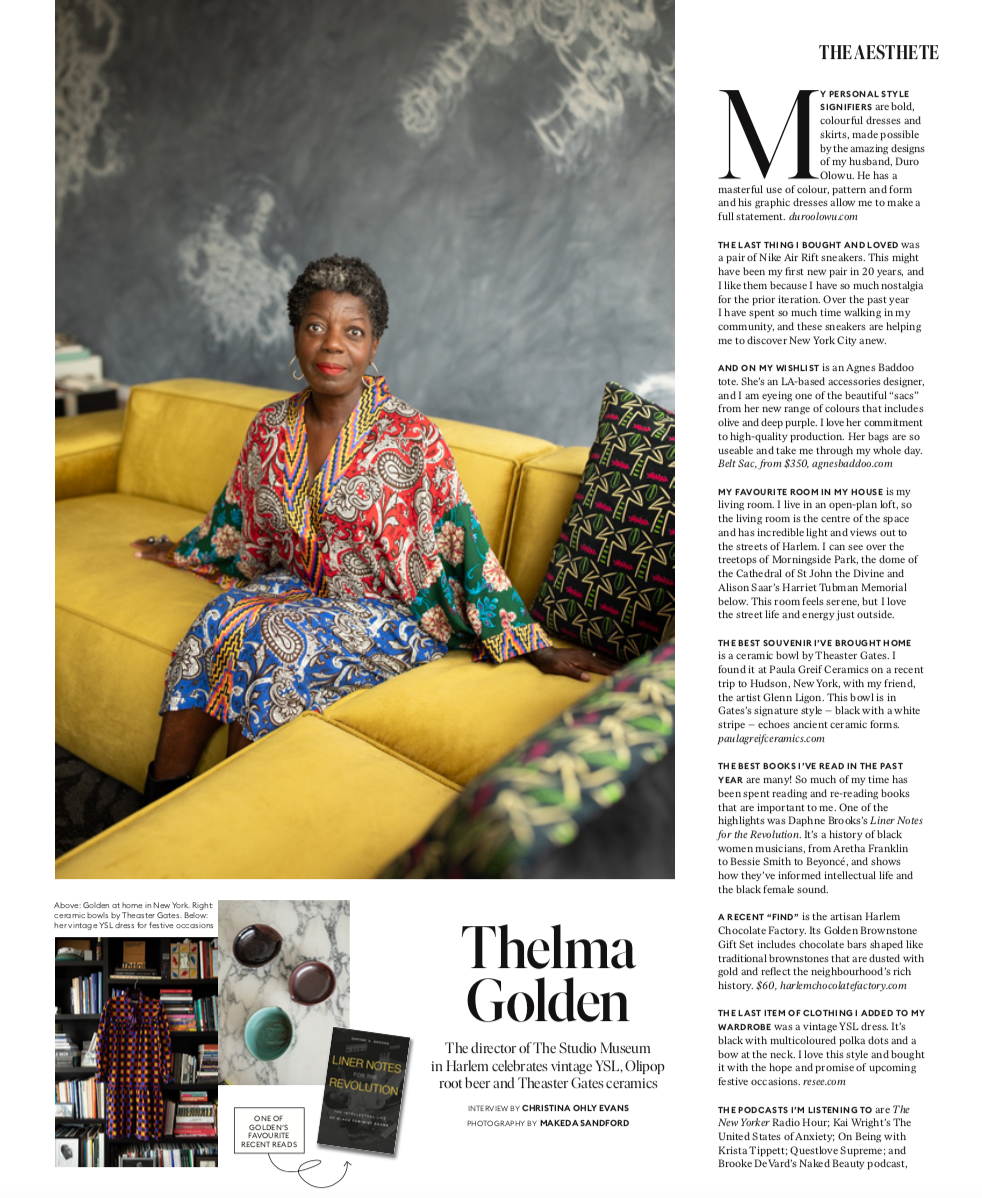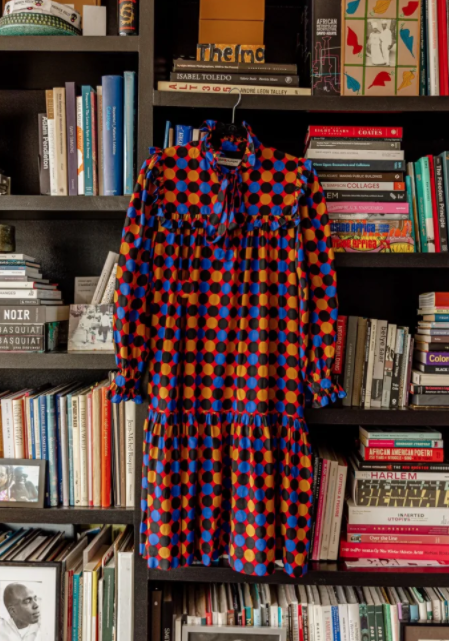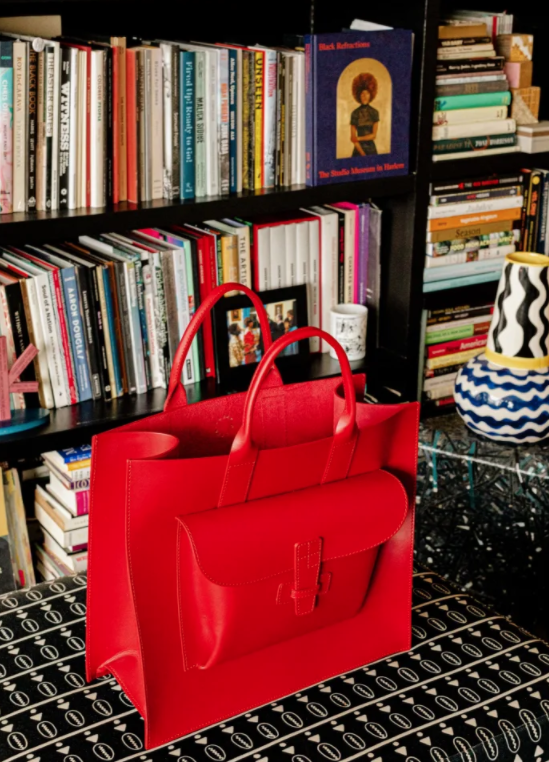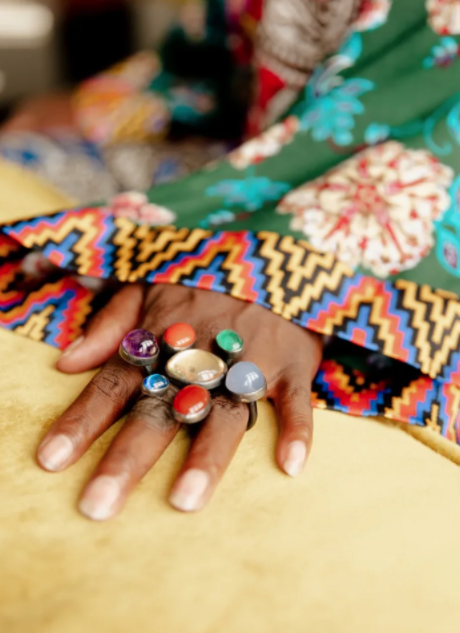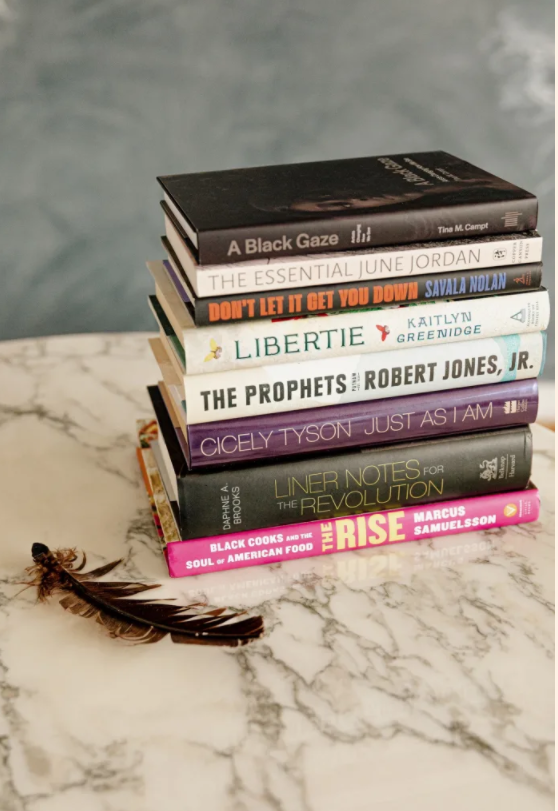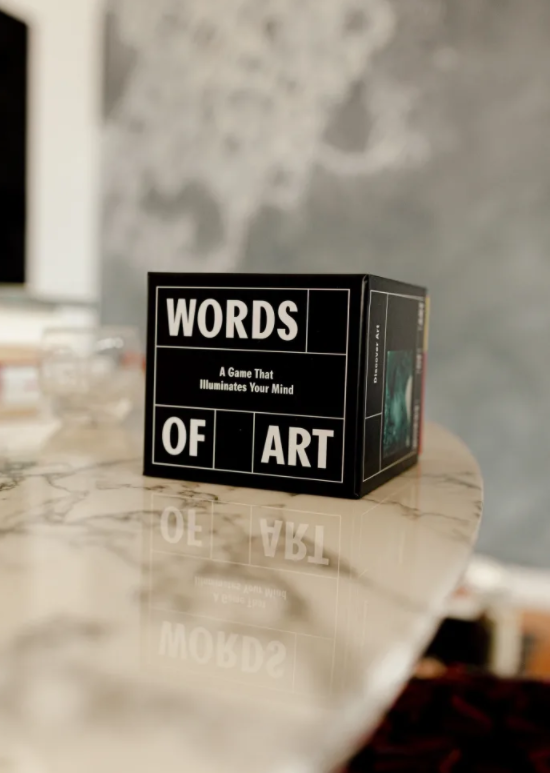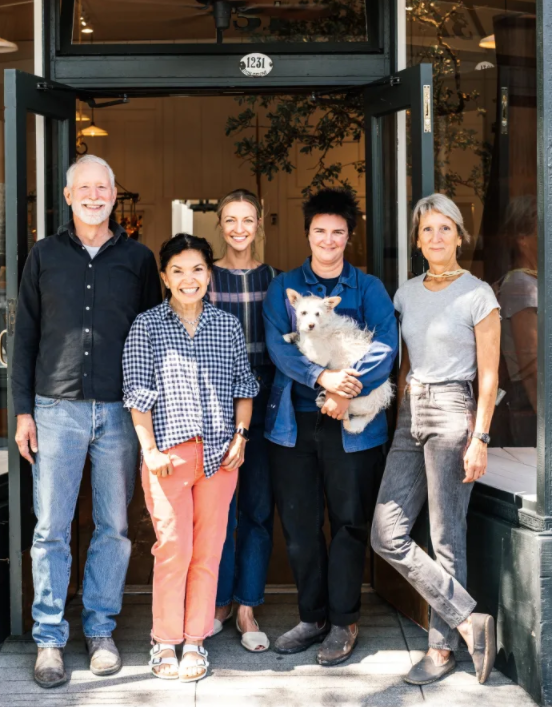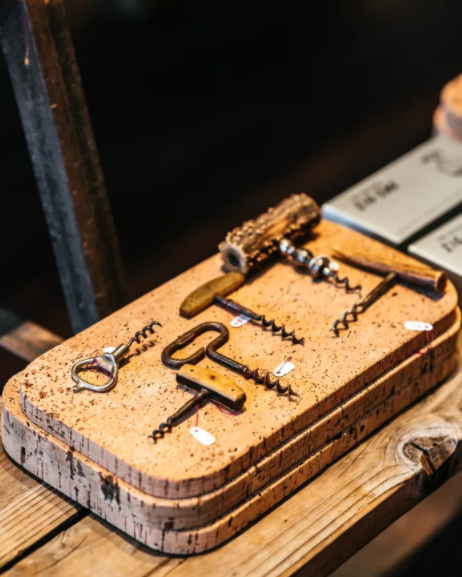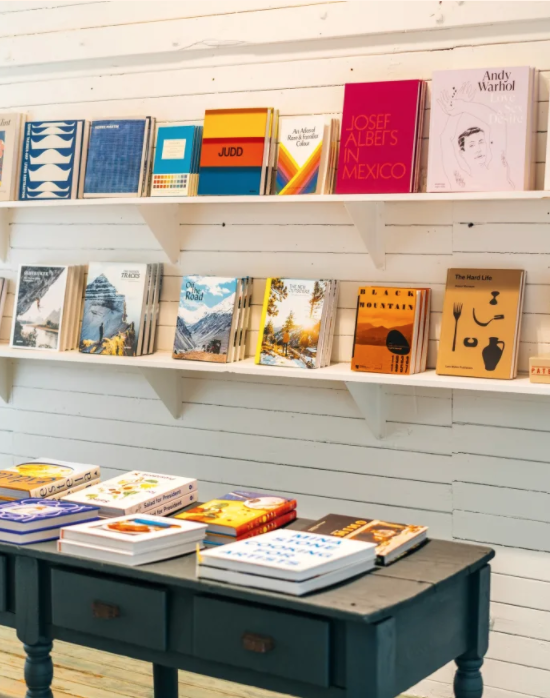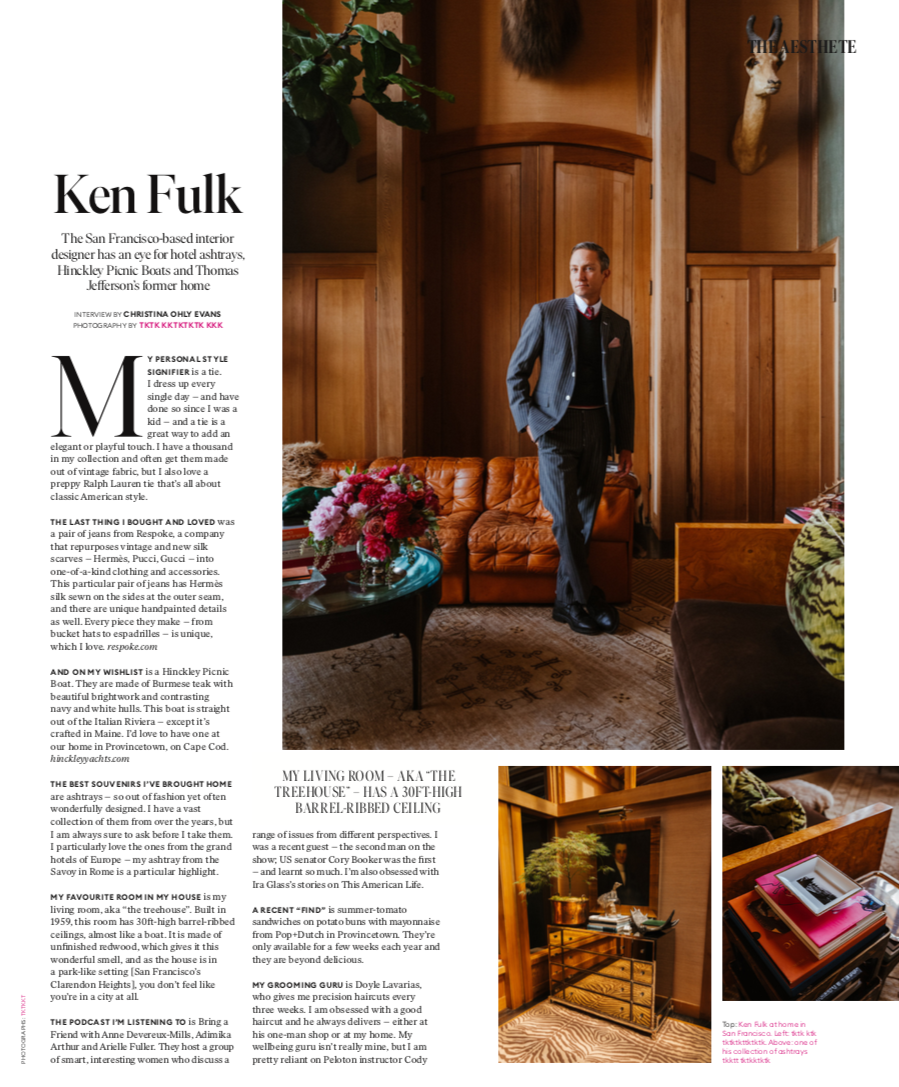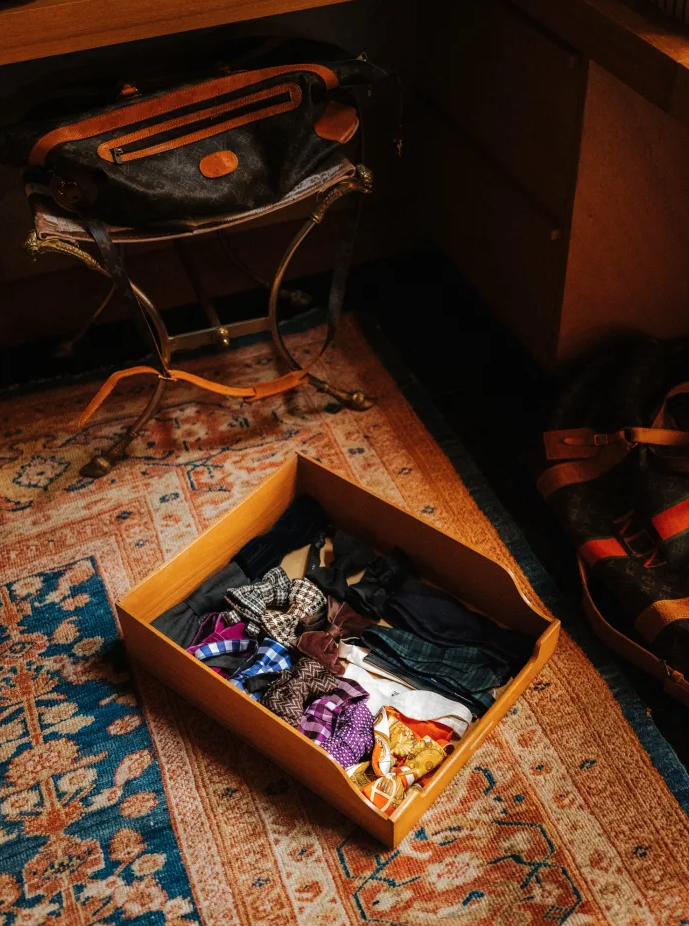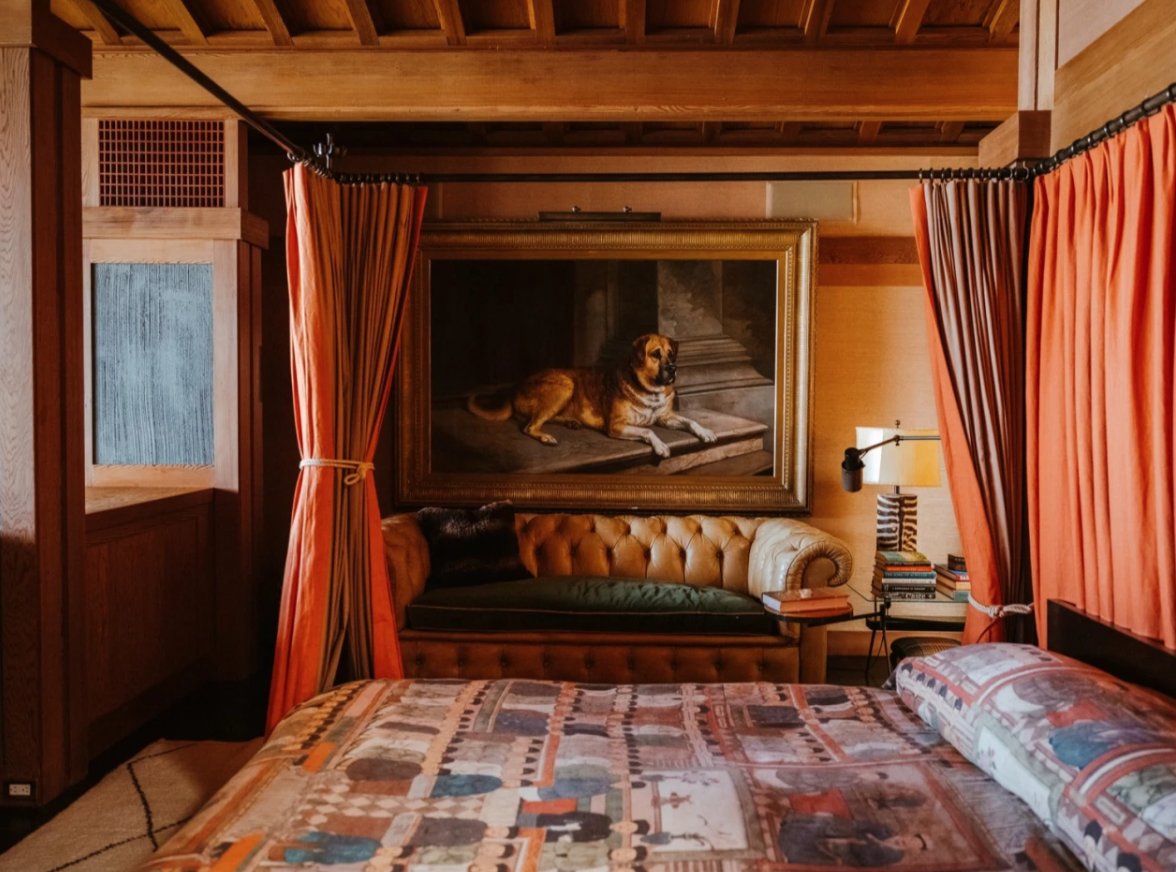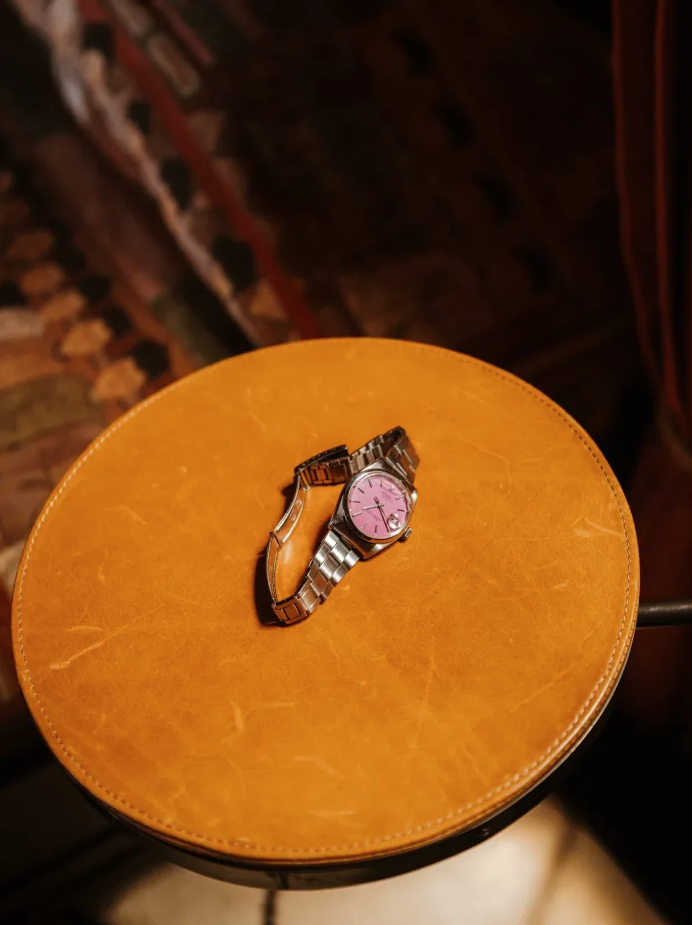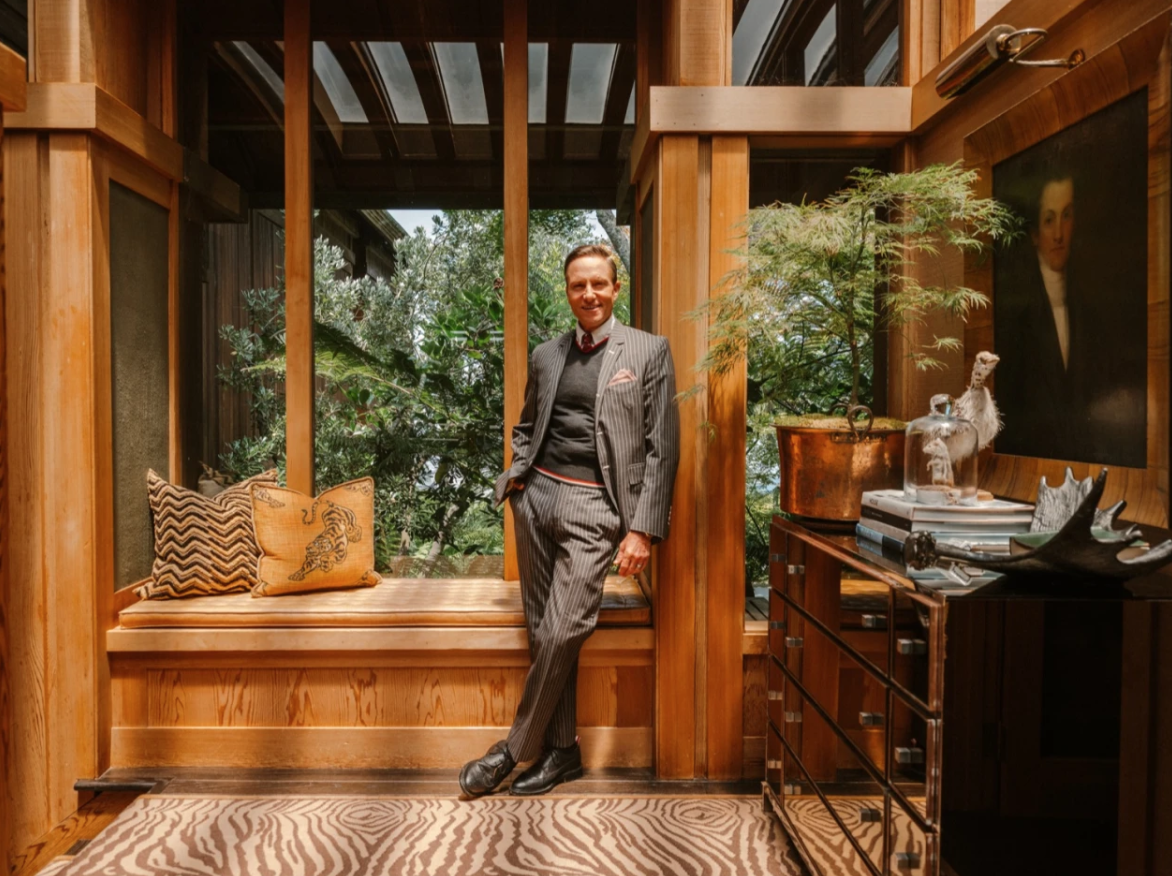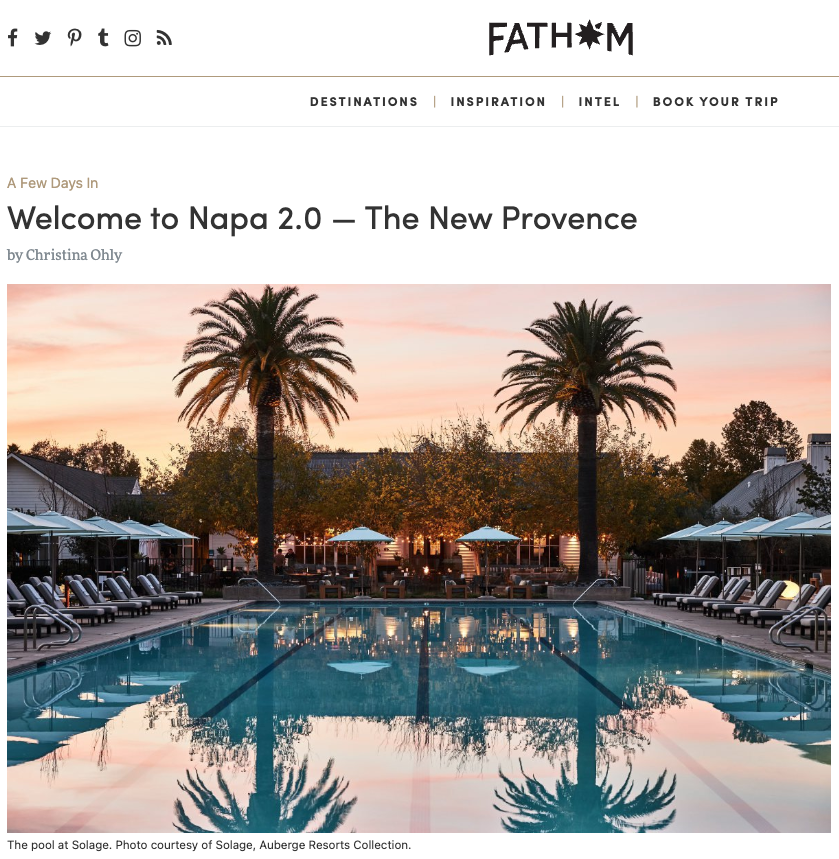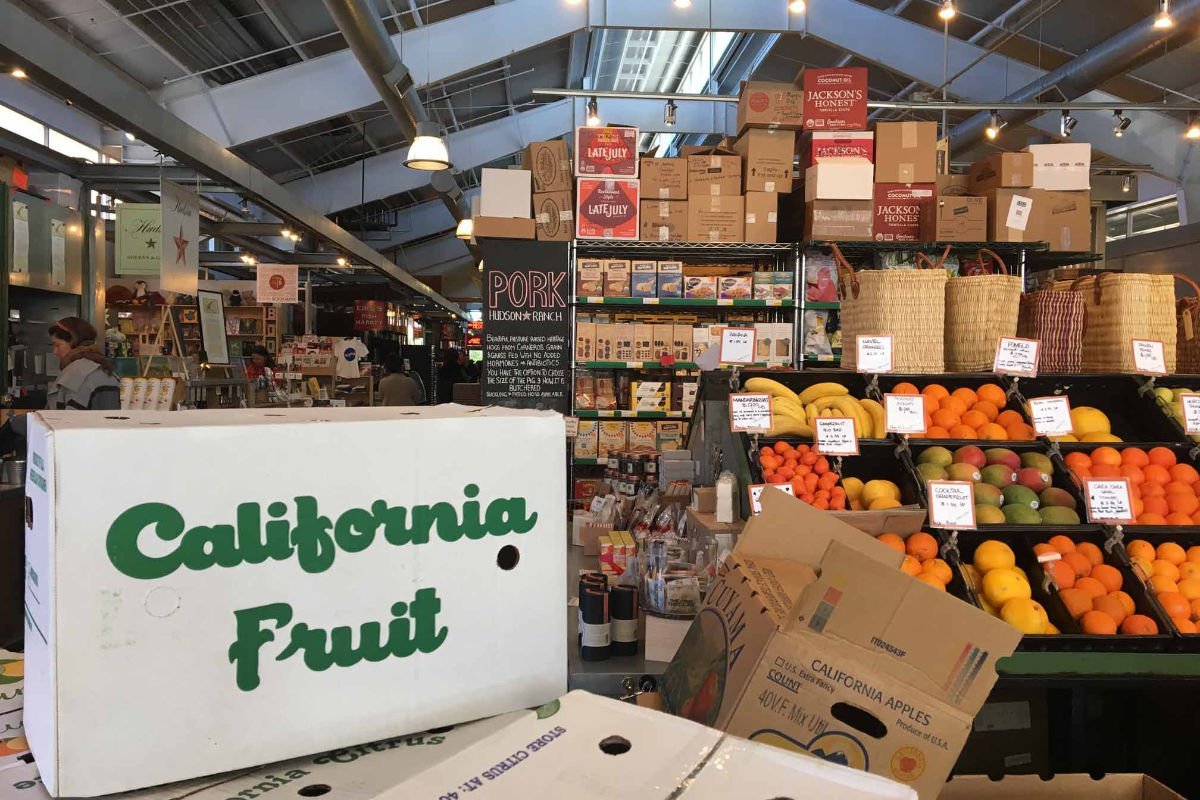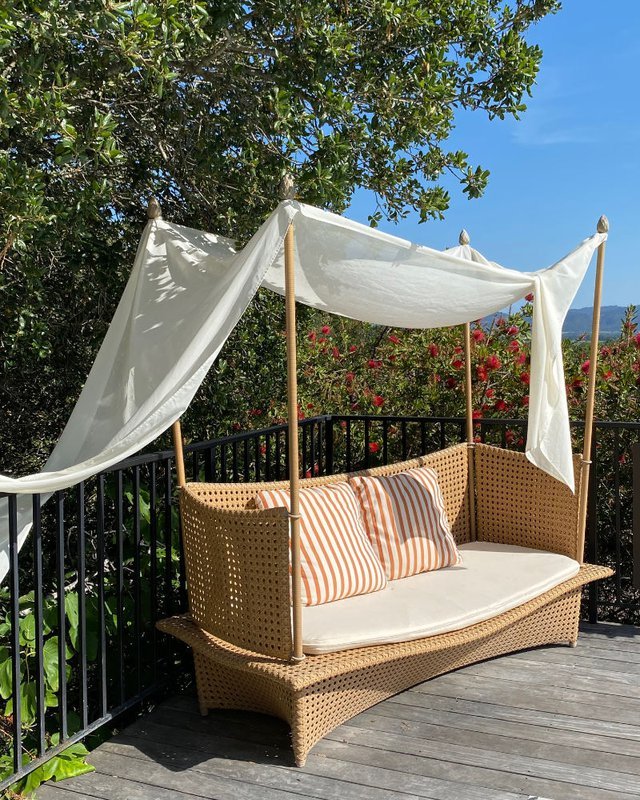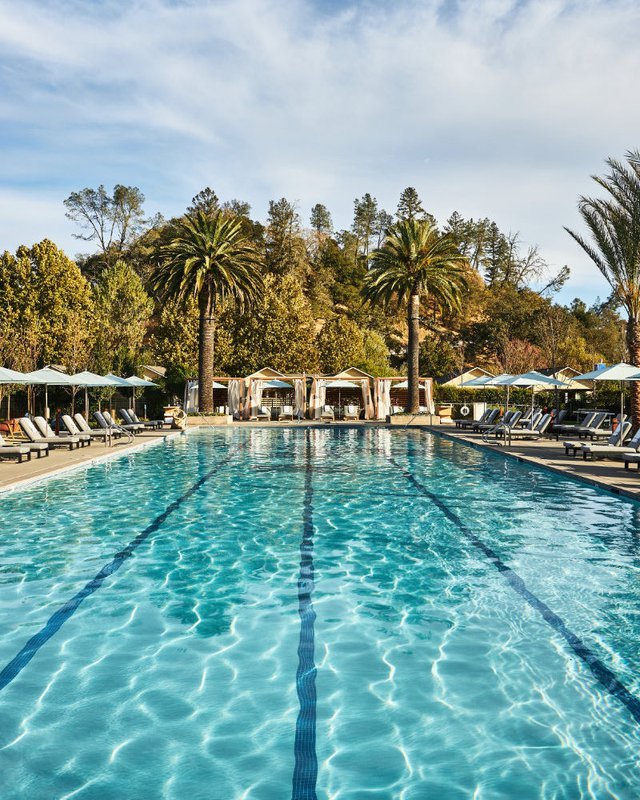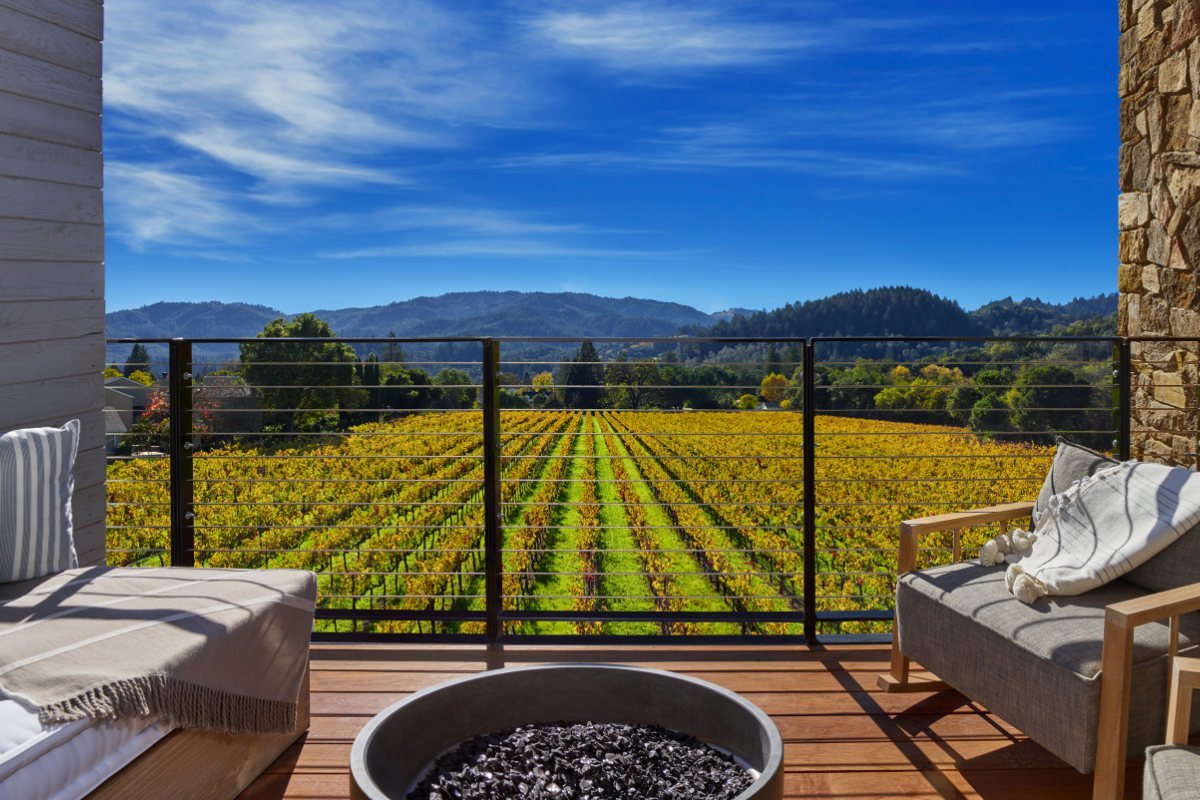Curator Thelma Golden talks taste
The director of The Studio Museum loves the view from her window, her Kara Walker pitcher and the Harlem Chocolate Factory
The director of The Studio Museum loves the view from her window, her Kara Walker pitcher and the Harlem Chocolate Factory
My personal style signifiers are bold, colourful dresses and skirts, made possible by the amazing designs of my husband, Duro Olowu. He has a masterful use of colour, pattern and form and his graphic dresses allow me to make a full statement.
The last thing I bought and loved was a pair of Nike Air Rift sneakers. This might have been my first new pair in 20 years, and I like them because I have so much nostalgia for the prior iteration. Over the past year I have spent so much time walking in my community, and these sneakers are helping me to discover New York City anew.
Golden’s vintage YSL dress for festive occasions © Makeda Sandford
Her Nike Air Rift Breathe sneakers © Makeda Sandford
And on my wishlist is an Agnes Baddoo tote. She’s an LA-based accessories designer and I am eyeing one of the beautiful “sacs” from her new range of colours that includes olive and deep purple. I love her commitment to high-quality production. Her bags are so useable and take me through my whole day. Belt Sac, from $350, agnesbaddoo.com
My favourite room in my house is my living room. I live in an open-plan loft, so the living room is the centre of the space and has incredible light and views out to the streets of Harlem. I can see over the treetops of Morningside Park, the dome of the Cathedral of St John the Divine and Alison Saar’s Harriet Tubman Memorial below. This room feels serene, but I love the street life and energy just outside.
Golden’s Agnes Baddoo Sac 2 bag © Makeda Sandford
Ceramic bowls by Theaster Gates – Golden’s favourite souvenir © Makeda Sandford
Golden wears a ring by Art Smith, bought from the dealer Mark McDonald © Makeda Sandford
The best souvenir I’ve brought home is a ceramic bowl by Theaster Gates from his Chicago studio. I also recently found a vase at Paula Greif Ceramics on a recent trip to Hudson, New York, with my friend the artist Glenn Ligon. paulagreifceramics.com
The best books I’ve read in the past year are many! So much of my time has been spent reading and re-reading books that are important to me. One of the highlights was Daphne Brooks’s Liner Notes for the Revolution. It’s a history of black women musicians, from Aretha Franklin to Bessie Smith to Beyoncé, and shows how they’ve informed intellectual life and the black female sound.
Some of Golden’s favourite reads of the past year © Makeda Sandford
A recent “find” is the artisan Harlem Chocolate Factory. Its Golden Brownstone Gift Set includes chocolate bars shaped like traditional brownstones that are dusted with gold and reflect the neighbourhood’s rich history. $60, harlemchocolatefactory.com
The last item of clothing I added to my wardrobe was a vintage YSL dress. It’s black with multicoloured polka dots and a bow at the neck. I love this style and bought it with the hope and promise of upcoming festive occasions. resee.com
Golden at home in New York © Makeda Sandford
The podcasts I’m listening to are The New Yorker Radio Hour; Kai Wright’s The United States of Anxiety; On Being with Krista Tippett; Questlove Supreme; and Brooke DeVard’s Naked Beauty podcast, which looks at beauty through the lens of culture. New York Public Radio’s The Brian Lehrer Show is essential for the latest local and national news. All of that is just the tip of the iceberg. My days are filled with meetings and calls, so listening to podcasts in the early mornings and late at night is a form of relaxation.
My style icon is the late actress Roxie Roker, who played Helen Willis in the 1970s TV series The Jeffersons. Her pleated skirt and blouse combinations, her great capes and chic wraps – she embodied the style of that era and of being a modern woman. I viewed her with awe. Her style remains the epitome of elegance and sophistication.
“Black Is Beautiful” onesies from The Studio Museum © Makeda Sandford
The best gifts I’ve given recently are “Black Is Beautiful” onesies to some new humans who have just come into the world. $20, studiomuseum.org
And the best gift I’ve received recently is a Lorna Simpson merino-wool blanket. It’s incredibly soft, measures 5ft by 8ft when unfurled and really is representative of her body of work. This amazing blanket was made in celebration of my 20 years of leadership at the Studio Museum and I’m honoured to have the prototype. $1,200, hauserwirth.com
My grooming and wellbeing gurus include hair stylist Edris Nicolls, who has done my hair for years, and facialist Crystal Greene of Crystal Greene Studio in Hudson Square. For fitness, I rely on trainer Tiffany Mason at Harlem Pilates and also my good friend Elena Brower for strengthening yoga. elenabrower.com
Golden’s merino blanket by the artist Lorna Simpson © Makeda Sandford
Her grandmother’s colander – one of her most treasured objects © Makeda Sandford
In my fridge you’ll always find Oatly oat milk, Trader Joe’s pineapple juice, Olipop root beer and Serengeti chai tea. There are endless condiments, including Tamarind Oh! from Essie Spice that I use on everything from poultry to vegetables. I also have greens from the Harlem Farmers’ Market, and there is always ice cream from Sugar Hill Creamery. They once named a flavour for me – Golden Chai – and I’m hoping they’ll bring it back.
I have a collection of limited-edition functional objects by a range of artists. One of my most prized is a sculptural pitcher by Kara Walker. I also have a set of plates from the Coalition for the Homeless project that includes designs by Derrick Adams and Adam Pendleton. These objects allow me to have these artists in my life in ways outside of the museum.
The objects I would never part with are my grandparents’ and my parents’ things: a colander that I saw in use throughout my entire life; my mother’s crystal serving bowl; the china that my father bought for my grandmother in Japan, when he served in the army; the 1970s ashtray that my parents bought in Spain; and my father’s pocket squares.
An indulgence I would never forgo is an Ethiopian spice mix called berbere. I was introduced to it by chef and restaurateur Marcus Samuelsson of Red Rooster in Harlem, and it has so informed my approach to cooking and being adventurous with flavour. It’s a mild chilli spice, but with hints of citrus and smoke.
Glenn Ligon’s limited-edition plate, Warm Broad Glow, 2005, for The Coalition for the Homeless’ Artist Plate Project © Makeda Sandford
Golden’s bust of WEB Du Bois by Inge Hardison © Makeda Sandford
The one artist whose work I would collect if I could is Alma Thomas. When I was a student at Smith College, I got an internship at The Studio Museum in Harlem where I learned about her work. Her story inspired me and set me on my career path. She was deeply engaged in the civic life of Washington, DC, and in 1972, she was the first African-American woman to exhibit at the Whitney Museum of American Art. I’d like any of her paintings; I adore her work. We also share a birthday – 22 September – so I feel a connection to her spirit.
The beauty staples I’m never without include Nars Velvet Matte Lip Pencil in Infatuated Red; Pattern Heavy Conditioner for Coilies; Vintner’s Daughter Active Botanical Serum; Hyper Clear Brightening Clearing Vitamin C Serum; Hanahana Beauty Shea Body Butter; and, last but not least, Ami Cole Lip Treatment Oil, which moisturises and adds a hint of colour. Ami Cole Lip Treatment Oil, $20. Hanahana Shea Body Butter, $28. Hyper Clear Brightening Clearing Vitamin C Serum, £32. Pattern Heavy Conditioner for Coilies, $25. Vintner’s Daughter Active Botanical Serum, $185
The work of art that changed everything for me was a bust of WEB Du Bois by the artist Inge Hardison, who was a friend of my mom’s. Hardison was a sculptor in the ’60s who created busts of prominent African-Americans – Frederick Douglass, Sojourner Truth, Dr Martin Luther King. This piece was probably the first work by an artist that I seriously engaged with as a child.
A recent discovery – the Words of Art card game © Makeda Sandford
I’ve recently discovered Words of Art by Catherine Gund. It’s a collaborative card game that uses art from renowned collector/philanthropist Agnes Gund’s private collection as a prompt for conversation and connection. $37.50, penguinrandomhouse.com
The websites and apps I use most are The New York Times, Artforum, ARTnews and Artnet. Then Todoist for organised listmaking and Audm for discovering long-form journalism. The last music I downloaded was Jason Moran’s The Sound Will Tell You. The piano recording came out at the same time as an exhibition of his works on paper, and I love that it was inspired by Toni Morrison. I am currently listening and re-listening to anything by Joni Mitchell, Laraaji Clay’s Moon Piano and Esperanza Spalding’s Songwrights Apothecary Lab, which is mesmerising, hypnotic and fills me with emotion.
The gadget I couldn’t do without is a Chef’n Looseleaf Kale and Herb Stripper for cleaning mustard greens and collard greens. I learned about it on Instagram Live, and it’s been the most amazing innovation for me as it saves so much prep time. $11.95, surlatable.com
If I weren’t doing what I do, I would be a film producer or a talk-show host because I love the opportunity to connect with creative people. I’ve always been a huge film buff, so this would be an excellent second career.
Cynthia Nixon talks taste
Cynthia Nixon talks taste
The actress loves teapots, Enstrom toffee and her boots by SJP
The actress loves teapots, Enstrom toffee and her boots by SJP
My personal style signifier is bold silver jewellery – usually Native American, Indian or Moroccan – especially a collar necklace that I never take off. I sleep in it and it makes me feel armoured and powerful. I also always wear a single flower on a chain that I bought in New Mexico – it’s by James Faks, who is affiliated to the Blackfeet and Oneida Nations – and a star that was my SATC character Miranda’s back in the day. They just make me feel great. The last thing I bought and loved was an enormous teacup that says “Queer” that I found at Fishs Eddy in New York.
The best souvenirs I’ve brought home are colourful rugs I bought while filming in Morocco. We have them scattered throughout our house in Montauk. Because we have so much sunlight, they have faded over time, but I love that they aren’t heavy or ornate. The best book I’ve read in the past year is Smile: The Story of a Face by playwright Sarah Ruhl. She developed Bell’s palsy after the birth of her twins, which impaired her ability to smile or show emotion. Her story is intimate and revealing about what it is to smile and what it means when you can’t. I am her friend and didn’t know the details, and her personal story touched me deeply.
A recent “find” is the restaurant Hwa Yuan in Chinatown. The Peking duck, cold sesame noodles and other Szechuan dishes are on another level. The podcast I’m listening to is Little Known Facts with Ilana Levine. She’s an actress who interviews all kinds of artists and celebrities and she’s like Barbara Walters in the way that she puts them at ease. For SATC fans of the character Stanford Blatch, I highly recommend the two-part episode she did with Willie Garson, who played him. I’ve also been listening to Sounds Like Hate, which is a revealing examination of white supremacy. An indulgence I would never forgo is toffee. I give boxes as gifts and people make it for me as well. My freezer is filled with homemade toffee, but I also love Enstrom’s almond version, which is made in Colorado. From $26.75 for 454g
My style icon is the actress and producer Christine Baranski. We’ve been friends forever and she is endlessly chic; her hair, her sense of style, the way she lives her life. There is no better comedic actress – or kind person – and she is a role model. It was a joy to work with her again on The Gilded Age. I’ve recently rediscovered an old VHS tape of Howards End with Helena Bonham Carter and Emma Thompson that I watched with a close eye. It’s still every bit as wonderful as when it was released.
The best gift I’ve received recently is a pair of fur-lined, low-heeled taupe boots from Sarah Jessica Parker’s line. She gave them to me when we wrapped And Just Like That... and they are so comfortable that I just love them. I have a collection of teapots from all over the world, some of which I inherited from my mother and grandmother. I drink tea all day, every day and typically have three pots going at once. I have glass ones, metal versions, seashell-shaped pots, Russian and Japanese pots, and a Chinese one that my son brought back from his time studying abroad. In my fridge you’ll always find quinoa, avocado, curried chickpeas, pickled onions, roasted sweet potatoes and kale, which I combine to make salads. It’s also fully stocked with blue cheese, smoked salmon, eggs, milk, garlic oil and homemade kombucha. I cook all the time – we’re very Hobbit-y over here.
The gadget I couldn’t do without is a pineapple slicer-corer from Williams-Sonoma. It removes the tough core from the pineapple, making it easier to cut into chunks. I directed a play in 2014, and the cast and crew were so accustomed to my pineapple that everyone got one of these corers as an opening-night gift. $24.95
The best bit of advice I ever received was not given directly to me, but I love the sentiment. Laurence Olivier was once asked by a young actor what was the most important piece of advice he could share, and he replied: “How to become an old actor.” In other words, why are you in this and what will sustain you? You don’t start to get good for 30 years… The last item of clothing I added to my wardrobe was a thigh-length black raincoat with bell sleeves from Sweaty Betty. It’s stylish and practical. $198
An object I would never part with is a corner cupboard that my mother bought for my grandmother. After we bought our house in Montauk, I finally had a place for it and it’s full of dishes, teapots and all kinds of ceramics. The one artist whose work I would collect if I could is Kara Walker. Our kids went to school together and I bought one of her works at the school auction. I’d love to have more. I’d also like to own some Lucian Freud paintings. They’re not necessarily flattering, but I find his work beautiful, grotesque and psychologically penetrating. The place I can’t wait to go back to is Nantucket, off the coast of Massachusetts. I haven’t been in many, many years, but I remember the landscape, the light and the charm of a New England town.
The beauty staples I’m never without are Aurelia Cell Repair Night Oil – a hydrating lavender and neroli blend – and Cicapair Tiger Grass Colour Correcting Treatment for evening out skin tone. It’s green and takes the redness out of my skin, and it’s the perfect light moisturiser with SPF. Aurelia Cell Repair Night Oil, £62 for 50ml. Dr Jart+ Cicapair Tiger Grass Colour Correcting Treatment, £37 for 50ml My favourite room in my house is my kitchen in New York. It’s the central hub for family and we all sit around a central island with me at the head, so I feel like Captain Kirk. I like to sit here and read, putter, drink tea and pay bills – it’s warm and feels like the control station of the home.
My beauty and wellbeing gurus are Rebekah Forecast, who has been cutting my hair since 2000, and Matin Maulawizada, who does my make-up and is very much about healthy products. Alicia Lombardini is my stylist – I need a lot of help in this department – and we really listen to each other after so many years.
My favourite app is The New York Times Spelling Bee. I’m obsessed. The idea is to make as many words as you can using seven letters, and it changes daily. It’s a constant that I check in with every morning.
If I weren’t doing what I do, I would be a director, which isn’t so far from what I am doing now, but I love to be involved with TV, film and theatre and directing is a great way to do that. I’d love to be a writer, but it’s too solitary as I’m a very social person and love connecting with people. Being a therapist interests me too. The Gilded Age is available on Sky Atlantic and NOW TV
Jon Batiste: How To Spend It in New Orleans
The musician and bandleader of The Late Show with Stephen Colbert celebrates the laidback charm of his Louisiana birthplace
The musician and bandleader of The Late Show with Stephen Colbert celebrates the laidback charm of his Louisiana birthplace
I was raised in and around New Orleans and associate the city with my grandparents and my extended family. Growing up, I went to St Augustine, a historically all-black high school known for its rigorous academics and athletics, as well as for the Marching 100, a band that is renowned in the South. I also attended the New Orleans Center for Creative Arts (NOCCA), Louisiana’s premiere arts conservatory. My cousin, Alvin Batiste, was the creative director, and the jazz training is at the level of Juilliard.
The historic intermingling of cultures here encourages creativity: there is no place quite like it. The 1700s are still felt in Congo Square – sacred land – and in the French Quarter with Jackson Square, Bourbon Street and the monuments that are both beautiful and problematic. New Orleans is the ground zero of the cultural explosion that came out of the stain of slavery.
Liuzza’s by the Track Lounge & Grill © William Morgan/Alamy
NOCCA winter jazz festival
The citizens here have a built-in expectation that we will live through rising tides and climate change. Hurricane Katrina tested our strength with devastating force and then, on the 16th anniversary of that storm, Ida struck the city. The levees held better this time, but we still haven’t done enough to draw attention to global warming and to help the many who have been displaced.
The key to New Orleans is how understated everything is; the unadorned spots are always the best. Verti Marte in the French Quarter is like a convenience store that sells the best po-boys – it’s the French bread that makes the difference. Mahony’s fried shrimp version is great too. Liuzza’s by the Track is another favourite for BBQ shrimp, and I go to Dooky Chase’s for all the New Orleans classics: red beans and rice, étouffée and seafood gumbos. The city is known for beignets – fried dough sprinkled with sugar – and my favourites can be found at Café du Monde on Decatur Street, which is an institution. But Tastee Deli-Donuts in the Seventh Ward is fantastic as well. And then there is Manchu Kitchen – a Chinese restaurant infused with all the flavours of New Orleans. Food is central to experiencing the city and you have to go all in – it isn’t about being healthy.
Jon Batiste in New Orleans © Rambo Elliott
The Ernest Hemingway suite at Hotel Monteleone
For great places to stay, I like the Hotel Saint Vincent in the slow-paced Lower Garden District, in part because it was inspired by music: hotelier Liz Lambert came up with the idea on a night out with musician St Vincent. Built in the 1860s, it feels very cool, with a beautiful courtyard and a French-Vietnamese café. The Hotel Monteleone in the heart of the busy French Quarter is a historic property run by the fifth generation of the same family. It has a rich literary past, having hosted Truman Capote, Ernest Hemingway and Tennessee Williams.
Hotel Saint Vincent in the Lower Garden District
Beignets and chicory coffee at Café du Monde © Robert Harding/Alamy
Music is a huge focus everywhere but, for me, one of the best venues is Preservation Hall. I love to go here and listen to drummer Shannon Powell, aka “the king of Tremé”, the New Orleans neighbourhood where he grew up. For fantastic jazz and Creole jambalaya, Snug Harbor on Frenchmen Street is the spot, although you can’t go wrong with any of the clubs along that strip. And the New Orleans Jazz Museum in the old US Mint gives a comprehensive look at the birthplace of jazz, as well as live performances.
Jon Batiste in City Park, New Orleans © Rambo Elliott
New Orleans is such a small city that I recommend getting a bike and just riding through the Garden District, along Chartres Street and ending up at the Mississippi River. The whole tour will take you three hours – between breakfast and lunch. Mardi Gras in spring is very particular to New Orleans, and the jazz festival in May is another special time. Founded by my mentor, George Wein, this celebration of music, art and culture is set to take place in spring 2022. And an unmissable holiday moment is the Christmas Eve bonfires on the levee. This is a Cajun tradition where elaborate structures are set ablaze, lighting up the sky and the Mississippi River. Jon Batiste’s latest album We Are is available on Verve Records
Franco Loro Piana: How To Spend It in Piedmont
Franco Loro Piana – the founder of activewear label Sease – offers a tour of his ‘true home’ in the Italian Alps
Franco Loro Piana – the founder of activewear label Sease – offers a tour of his ‘true home’ in the Italian Alps
My Dutch-German grand-mother escaped to the Valsesia valley, near the Swiss border in the western Alps, in the second world war. It was here that she met my grandfather, Franco, a second-generation wool merchant and manufacturer. Together with their sons, Sergio and Pier Luigi, and my aunt, Lucia, they developed our family business, Loro Piana, in this authentic, rugged part of Italy. The area is my true home and where I lived until I went to university. I grew up skiing after school here, and it’s where I made my lifelong best friends. The setting is beautiful – in the shadow of Monte Rosa yet an easy escape from Milan and Turin – and the pace of life is slower and simpler. It’s also perfect for hardcore ski touring, mountaineering, ice climbing and biking.
Rimasco, one of the region’s lakes © Lea Anouchinsky
The main Valsesia valley branches off into secondary valleys and in one lies the little village of Rima. My grandmother’s house – a typical stone and wood structure in the Walser style – still stands, and it is one of 50 or so original buildings. I spent my summers here hiking, swimming in the rivers and learning to sail in the nearby lake. Autumn is equally beautiful, with foliage that is so dramatic it’s like being in Japan. The mountainous trails are steep and challenging – regardless of the season – so whether you are deer hunting or climbing up for virgin powder runs, I highly recommend a guide to help navigate the challenging terrain.
Loro Piana in the Heidi restaurant © Lea Anouchinsky
Rima is magical and you can completely disconnect from the rest of the world; it’s one of the few places left that are so far removed. I love to stop by Ristorante Alpino (+39 347 416 0781) in the main piazza to eat la miaccia – flatbread stuffed with local Toma cheese and pancetta. On the way down the valley, stop at the restaurant Il Giacomaccio if you want a hearty dinner – they serve the area’s speciality, polenta with deer, as well as the local Travaglini wines. I bought my first mountain bike here at Locca and love to ride the 100-mile trail almost year-round. It’s likely you’ll never run into anyone along the Balmuccia-Alagna trail that runs along the valley of the river Sesia. This is also a top-notch spot for rafting and fly fishing. In fact, Yvon Chouinard, the founder of Patagonia, came here to learn from local fly-fisherman Mauro Mazzo. He uses a very specific technique called Tenkara, using just a rod and a fixed line, and makes special reels. There are rustic, family-run places to stay nearby including Locanda Margherita in Rassa and the Ristorante Residence Giardini in Piode. But for real local colour, try one of the remote refugios – some are accessible only by helicopter. One of the most spectacular is the Margherita Hut, at 4,600m. You can hike up – it takes at least nine hours – and spend the night in Europe’s highest refugio, then ski down at dawn. For something a little more comfortable, try the chalet-style MH Cristallo.
The Heidi restaurant in Rassa...
... and Loro Piana on its terrace © Lea Anouchinsky
On the west side of the valley, the village of Mera is set right on the slopes and reachable only by walking or by cable car. Sleeping on the slopes in a mountain hut is a unique feeling. I learned to ski here, and have had magical winter nights ski-touring with the full moon lighting the way. In the past few years, I’ve returned to ski touring and I like to hike up – with the deer, foxes, rabbits and birds – before descending from 2,000m at the top of the mountain down to the village that sits at 1,000m. After a full day of skiing, you can’t miss a sunset aperitivo on the slopes at Il Baretto (+39 328 908 9493) – just grab a beer and enjoy the majesty of the Monte Rosa, which sits right in front of you in multiple shades of pink.
At 4,600m the Margherita Hut is the highest refugio in Europe
Keep going up the valley, along the river Sesia, and you’ll find the towns of Scopello, Piode and Riva Valdobbia, all leading up to the main village of Alagna, where the road ends. Alagna is the most important ski area in the western Alps, with more than 95km of amazing slopes and a cable car that takes you up to the glacier at 3,000m. The area is known for its very technical, off-piste terrain that draws skiers from as far afield as Sweden and Norway.
A suite at Villa Crespi, where there is also a two-Michelin-starred restaurant © Francesca Pagliai
A fresco at Sacro Monte di Orta © Alamy
Malfatta is one of the best lines here and a guide is a must for the 50-degree chutes. There are some legendary guides like Silvio Mondinelli, who has hiked up K2 and Mount Everest, but Guide Alpine Alagna will also find you an expert who knows every corner of this complicated terrain. The legendary La Balma is another favourite run for fresh powder on the glacier. For a nice ski break, stop at a slopeside hut called Der Shoppf (+39 348 330 7292) to enjoy local food and get some sun on the terrace. There’s also a little bar for the end of the day – Caffè delle Guide (+39 0163 923 209) – where the guides hang out. Or try Cà Nosta in the piazza for a simple dinner before heading to Da Mario (+39 0163 910 28) for an epic gin and tonic to end the night.
The family-run Locanda Margherita
At the bottom of the valley is Lake Orta. It’s west of Lake Maggiore and about one-eighth the size of Lake Como, but there is still so much to do, including exploring the town of Orta San Giulio, which is full of piazzas and cafés but with few cars. Don’t miss a meal at Villa Crespi’s two-Michelin-starred restaurant, helmed by chef Antonino Cannavacciuolo – it’s worth booking well ahead.
Loro Piana in the Valsesia valley © Lea Anouchinsky
In the middle of the lake is the Isola di San Giulio, an island that is home to a 12th-century basilica and a 19th-century monastery. One of the most amazing things here is the Sacro Monte di Orta (part of a Unesco World Heritage Site of 20 chapels) that has incredible frescoes and overlooks Lake Orta and the town. This part of Piedmont is blossoming, with a new generation coming in and supporting growth. Like many regions in Italy, it is still under the radar, but its beauty and authenticity, as well as its proximity to the cities, makes it very special.
Cult Shop: consciously sourced cool in California wine country
A self-styled antidote to throwaway culture, Carter and Co showcases artisanal homeware, sustainable fashion and local produce
A self-styled antidote to throwaway culture, Carter and Co showcases artisanal homeware, sustainable fashion and local produce
I’m not into throwaway culture,” says artist, potter and sculptor Richard Carter. “People increasingly want things that are handmade, environmentally sensitive and can’t be found elsewhere. They also want to meet the makers and hear their stories.” After seeing empty storefronts in the Napa Valley town of St Helena, he put his beliefs into practice and in May 2019 opened Carter and Co, a lifestyle store selling artisanal homeware, sustainable fashion and locally sourced produce. Carter set about a meticulous restoration of a 19th-century store – which had been first a butcher’s, then a tailor’s and later an antiques shop. “I felt its soul and history immediately,” says Carter of the now soaring, light-filled space with its white plastered walls, waxed fir floors and wooden dressmaker’s shelves.
From left, owner Richard Carter, Michelle Neal, Erin Radcliffe, Chelsea Radcliffe with dog Oliver, and Toby Hanson © Emma K Morris A set of six French walnut steak knives, $450 © Emma K Morris
A set of six French walnut steak knives, $450 © Emma K Morris
Vintage corkscrews, from $35 © Emma K Morris
Please use the sharing tools found via the share button at the top or side of articles.
Many of the original store features are used to display items. The wide-ranging book selection is showcased in a restored meat locker; magnificent sculptural bowls ($2,000) and crystalline cloches ($2,600) by architect and glassblower Joshua Parke sit atop a zinc-topped wooden worktable; and rare copper pots and handcrafted knives are on an original butcher’s block. The store is particularly celebrated for its varied selection of dishware, which is inspired by designs created by Carter and artists-in-residence at his studio on his 85-acre ranch in nearby Pope Valley, and fired in the estate’s Japanese wood-burning kilns. Much sought after is the “dirty” porcelain that “contains iron and is more textural”, made in collaboration with the nearby three-Michelin-starred Meadowood restaurant; especially beautiful is the Shed line of ceramics ($38-$195) fired in a salt kiln to give them an ethereal, mottled green veneer.
The wide-ranging book selection is showcased in a restored meat locker © Emma K Morris
Millon and Clark walnut board, $184 © Emma K Morris
Carter’s time spent as a chef at Thomas Keller’s The French Laundry, three-Michelin-starred as well, has also nurtured a special interest in top-quality culinary implements (“I love caring for good tools – especially if there’s a backstory involved”), and the array here includes hand-forged Swedish axes by Gransfors Bruk ($153), Tetu cast iron kettles ($615) and chopsticks ($10). The most striking piece is a spectacular carbon steel fire pit ($9,000) that Carter designed at the ranch during lockdown. Foodie highlights, meanwhile, include locally produced honey and olive oil. But it’s not all practical housewares. Clothing includes hand-sewn deerskin jackets in tan, gold and chocolate by nearby Marin-based Susan Kim ($1,500-$1,700), while decorative objects include Japanese hollow taper candles ($28) and Breu resin incense ($18). To keep things feeling fresh, Carter also hosts regular pop-ups (most recently with ethical-clothing brand Dosa). “We felt like we could do retail better,” he concludes. “I keep the place spare and change it often. People come to discover niche things that are sustainable and made with love.”
Climber and filmmaker Jimmy Chin talks taste
The director of The Rescue on crampons, Ansel Adams – and decompressing with a Dyson
The director of The Rescue on crampons, Ansel Adams – and decompressing with a Dyson
My personal style signifiers are simple, comfortable, practical clothes: a navy or white James Perse T-shirt, Hiroshi Kato jeans and a North Face Purple Label Japan insulated, button-down, collarless shirt that I take with me wherever I go.
The last thing I bought and loved was a surfboard shaped for me by Matt Biolos of Lost Surfboards in Hawaii. My family spent several months there last year, and he shaped my Quiver Killer board and two special shortboards for my kids. Like a tailored jacket, a custom board is just for you.
A “Quiver Killer” surfboard crafted for Chin by his friend Matt Biolos © Shannon Corsi
Chin’s photo of friends skiing on Mount Everest in 2006 © Shannon Corsi
And on my wishlist is a Ford F-150 Lightning Electric pick-up truck, with a four-door cab and zero emissions. It’s perfect for the road conditions where I live in Jackson Hole, Wyoming, because it sits up high and has great clearance. In the summer I haul kayaks and mountain bikes, and in winter, it’s skis and climbing gear, so this is the perfect vehicle. I’d also love a new Dyson V10. Upon re-entry from an expedition, vacuuming is my way of getting reacclimatised.
The places I can’t wait to go back to are Patagonia in Argentina, and the Karakoram in Pakistan. Both countries have dramatic, granitic mountains that are perfect for alpine rock climbing. They have beautiful climbing lines.
Jimmy Chin on his bouldering wall in his garage © Shannon Corsi
And the best souvenir I’ve brought home is a photo that I took of friends skiing near the top of Everest. This was a shot that I don’t think anyone had ever snapped before and it represents the intersection of my life as a documentarian and also a climber. It’s a reminder of a very special expedition moment and one that I couldn’t have set up.
I have a collection of knives from all over the world. Whether from Chad, Oman, Nepal or Mali, they have cultural significance and are relatively easy to bring home. My favourite is one that was given to me on a National Geographic trek across the Changtang Plateau in Tibet.
Knives from Chin’s collection and some of his mountaineering memorabilia © Shannon Corsi
2034: A Novel of the Next World War – his favourite read of the past year © Shannon Corsi
The best book I’ve read in the past year is 2034: A Novel of the Next World War by Elliot Ackerman and Admiral James Stavridis. I studied international relations in college and like to stay up to date on geopolitics. This book was written with a lot of insight into how decisions are made – and how catastrophic decisions are made inadvertently.
A recent “find” is a restaurant called The Old House in Kathmandu. It serves Asian fusion cuisine, and it has a nice ambience and a very cool bar. I also recently discovered The Savoy in London – I usually stay in Soho, but the views of the Thames made my Covid quarantine very manageable.
The podcast I’m listening to is Alex Honnold’s Climbing Gold, which is all about rock climbing. I also try to listen to podcasts on both sides of the political spectrum – everything from The New York Times’s The Daily and Pod Save America to the conservative Ben Shapiro Show.
Chin in his van, parked in the lot where he is building a new house in Jackson, Wyoming © Shannon Corsi
The best gift I’ve given recently is a NOLS (National Outdoor Leadership School) course in Wyoming to my nephew, to celebrate his 16th birthday. I used to teach these outdoor leadership courses and I was amazed by how transformative they can be. From teamwork to self-confidence to leadership, the skills learned on a NOLS trip last a lifetime.
And the best gift I’ve received recently is edits from my friend, author Jon Krakauer. I was trying to finish my book, There and Back: Photographs from the Edge, and it was excruciatingly painful. In my moment of need, Jon stepped in.
In my fridge you’ll always find cheese – fancy or sliced and packaged, I love it all. I particularly like Humboldt Fog goat’s cheese and also Tillamook Sharp Cheddar. There are always blueberries for making smoothies in there, as well as plain yoghurt, almond milk, nutritional supplements and kale.
The tech I couldn’t do without is Bose QuietComfort 35 II wireless headphones, which I use to block out the world when I’m travelling. And I’m interested in the idea of a large-scale carbon-capture machine to convert carbon emissions into something usable to counter climate change.
Chin’s wireless Bose headphones – the tech he can’t do without © Shannon Corsi
Chin’s Panerai Submersible Flyback watch, which he helped to design © Shannon Corsi
The last item of clothing I added to my wardrobe was a black North Face Summit down hoodie. It’s simple, ultra-lightweight and easy to pack, and works as well in the mountains as it does in the city. I also added a Panerai Submersible Chrono Flyback watch that I helped to design.
I’ve recently discovered a restaurant called Coelette that has really upped the food game in Jackson Hole. It is European/Asian and would be noteworthy anywhere in the world, let alone in a small mountain town. Sturgeon with lacto carrot consommé and a soba dish with spruce tea are just two examples of the creativity here.
The one artist whose work I would collect if I could is Ansel Adams, because he was the forerunner of the outdoor photography genre in the American West.
The product that changed everything for me was the Canon EOS 5D camera that came out in 2008. For the first time, I could shoot photographs and film with one camera, and with a cinematic look too. This was a game-changer for me in terms of the weight of the gear I had to carry, and also not having to switch back and forth between two cameras and miss so many moments.
His Canon EOS 5D camera next to his well-worn passport © Shannon Corsi
“Just the smell of it is comforting”: Jack Black Intense Therapy lip balm © Shannon Corsi
The grooming staple I’m never without is Jack Black Intense Therapy lip balm with SPF 25. It’s small, easy to carry and very moisturising for dry, cracked skin all over the face. Just the smell of it is comforting. £7.95
An object I would never part with is a jade-dragon charm that was given to me by father for good luck on expeditions. It’s on a necklace, but I just keep it in my pocket.
My favourite room in my house is my gear room. I have tons of expedition gear, packs, ropes, rock collections, my knives, crampons from Everest, mementoes and old axes from important trips. Part office, part man cave, it’s the place where I can work in peace overlooking the Tetons.
Chin at home in front of a wall of climbing gear © Shannon Corsi
Hanah One botanical supplement © Shannon Corsi
My wellbeing gurus are Francine Bartlette of Medicine Wheel Wellness in Jackson for body work; and Joel Einhorn, of Hanah One, for ayurvedic supplements and herbs from Bhutan such as turmeric.
If I weren’t doing what I do, I would be a woodworker or a creative craftsperson of some kind. I love working with my hands and the satisfaction of having a finished product at the end of the day.
My style icon is my wife, filmmaker [Elizabeth] Chai Vasarhelyi. She navigates many different worlds and has innate style, having grown up in New York City. From dark jeans and a leather jacket with a vintage concert tee, to Chanel and Oscar de la Renta for the red carpet, she isn’t afraid to take risks.
A scene from Chin’s film The Rescue © National Geographic
The last music I downloaded was Taylor Swift’s album Folklore. My eight-year-old daughter is very into Taylor – and Ed Sheeran – so my playlists tend to reflect her interests.
An explorer’s best friends are patience and cautious optimism. Also a trustworthy partner, a belief in oneself and the ability to assess risk accurately.
An indulgence I’d never forgo is dessert. I have a terrible sweet tooth. If you put warm blueberry or pecan pie with vanilla ice-cream in front of me, I’m done. The Rescue, directed by Jimmy Chin, is out now
Ken Fulk: ‘I dress up every single day – and have done since I was a kid’
The San Francisco-based interior designer has an eye for hotel ashtrays, Hinckley Picnic Boats and Thomas Jefferson’s former home
The San Francisco-based interior designer has an eye for hotel ashtrays, Hinckley Picnic Boats and Thomas Jefferson’s former home
My personal style signifier is a bow tie or tie. I dress up every single day – and have done so since I was a kid – and a tie is a great way to add an elegant or playful touch. I have a thousand in my collection and often get them made out of vintage fabric, but I also love a preppy Ralph Lauren tie that’s all about classic American style.
The last thing I bought and loved was a pair of jeans from Respoke, a company that repurposes vintage and new silk scarves – Hermès, Pucci, Gucci – into one-of-a-kind clothing and accessories. This particular pair of jeans has Hermès silk sewn on the sides at the outer seam, and there are unique handpainted details as well. Every piece they make – from bucket hats to espadrilles – is unique, which I love. respoke.com
And on my wishlist is a Hinckley Picnic Boat. They are made of Burmese teak with beautiful brightwork and contrasting navy and white hulls. This boat is straight out of the Italian Riviera – except it’s crafted in Maine. I’d love to have one at our home in Provincetown, on Cape Cod. hinckleyyachts.com
The best souvenirs I’ve brought home are ashtrays – so out of fashion yet often wonderfully designed. I have a vast collection of them from over the years, but I am always sure to ask before I take them. I particularly love the ones from the grand hotels of Europe – my ashtray from the Savoy in Rome is a particular highlight.
My favourite room in my house is my living room, aka “the treehouse”. Built in 1959, this room has 30ft-high barrel-ribbed ceilings, almost like a boat. It is made of unfinished redwood, which gives it this wonderful smell, and as the house is in a park-like setting [San Francisco’s Clarendon Heights], you don’t feel like you’re in a city at all.
The podcast I’m listening to is Bring a Friend with Anne Devereux-Mills, Adimika Arthur and Arielle Fuller. They host a group of smart, interesting women who discuss a range of issues from different perspectives. I was a recent guest – the second man on the show; US senator Cory Booker was the first – and learnt so much. I’m also obsessed with Ira Glass’s stories on This American Life.
A recent “find” is summer-tomato sandwiches on potato buns with mayonnaise from Pop+Dutch in Provincetown. They’re only available for a few weeks each year and they are beyond delicious.
My grooming guru is Doyle Lavarias, who gives me precision haircuts every three weeks. I am obsessed with a good haircut and he always delivers – either at his one-man shop or at my home. My wellbeing guru isn’t really mine, but I am pretty reliant on Peloton instructor Cody Rigsby. I’m addicted to Peloton largely because his classes are so fun, and it feels like a personal relationship. Doyle Lavarias, 1135 Ellis Street #A103, San Francisco, CA (+1408-876 7187). Cody Rigsby, @codyrigsby
The last music I downloaded was Sing to Me Instead by Ben Platt. I loved him in Dear Evan Hansen on Broadway and this debut album is just as beautiful because his voice is so emotive.
The design that changed everything for me was Thomas Jefferson’s home Monticello in Charlottesville, Virginia. It’s near where I grew up – I visited many times as a child and it had a huge impact on my own design sensibilities. It’s a neoclassical building, rooted in the past, and yet it still feels very modern.
In my fridge you’ll always find oat milk for my morning coffee and splits of Ruinart rosé champagne for guests. If you’re offered champagne, never refuse – or so the saying goes. I also always have really good pickles and an assortment of jams. I’m obsessed with jam and typically have four kinds of Bonne Maman: cherry, blueberry, apricot and raspberry.
The best gift I’ve given recently is a glorious painting called Nocturne by the artist Salvatore del Deo to my husband Kurt for his birthday. We are huge fans of 93-year-old Sal – so much so that we named our dog after him – and this particular landscape features a dramatic sea and sky, just after sunset. I typically like to give experiences, but art brings continual joy that will endure.
The main bedroom, with its vintage dog portrait © Brian Flaherty
His vintage Rolex – a recent gift © Brian Flaherty
And the best gift I’ve received recently is a vintage Rolex in its original case from the year of my birth. A friend gave me this classic stainless-steel watch as a thank-you during the pandemic and it was so thoughtful and unexpected, which made it even more special. It’s simple and practical – not flashy at all – so it’s perfect for me.
I’ve recently rediscovered the card game Canasta and card-playing in general. I enjoy the social yet competitive aspects of this particular game. Cards are old world, no-tech and fun.
The gadget I couldn’t do without is a juice squeezer for the fresh lime juice I use to make Margaritas. They come in playful colours and it’s just a simple, old-fashioned hand squeezer – no electricity involved.
The best book I’ve read in the past year is a signed first edition of The Story of Edgar Sawtelle by David Wroblewski. I actually re-read this book as it’s a big Herculean read and I wanted to really enjoy it. It’s the story of a mute boy, his mythical dogs and of his coming of age in the wild. It’s heroic and was even better the second time.
Bookshelves in the study © Brian Flaherty
Fulk’s Cartier bracelet © Brian Flaherty
An object I would never part with is a silver band on my wrist that my husband gave me on our first wedding anniversary, almost 30 years ago. It’s very simple, with just a slight ribbon of gold. The other thing I wouldn’t part with is a Cartier Love bracelet in platinum that I’ve worn for 17 years.
An indulgence I’d never forgo is extravagant hotels. I’m a hotel junkie and subscribe to the theory that the best room really does matter. A beautifully designed hotel changes your whole view of a place. I’d also have a hard time giving up cashmere sweaters by Leret-Leret and Lingua Franca, custom-embroidered with clever symbols or sayings.
I have a collection of more than 200 pairs of cufflinks. My father gave me his collection and it blossomed from there. I have quirky ones, elegant sets – and a pair of Playboy bunnies from the 1960s. My favourite is an eye-catching set by Fornasetti. I only wear vintage cufflinks, never new.
Fulk’s cufflinks collection © Brian Flaherty
His Thom Browne blazer © Brian Flaherty
The last item of clothing I added to my wardrobe was a green- and cream-striped Thom Browne rowing-style blazer. It has frayed edges and a slightly deconstructed look.
The grooming staple I’m never without is Ultimate Brushless White Eagle Shave Cream by Kiehl’s. It contains menthol, which is slightly numbing, and if it were ever to be discontinued, I’d buy it in bulk as it’s vital to my daily routine. $18, kiehls.com
My favourite apps are Dark Sky for the weather because I’m always travelling, and 1stDibs because it allows me to shop for really specific pieces – like a Jean Royère screen – from wherever I am in the world. It’s indispensable for my work.
The one artist whose work I would collect if I could is David Hockney. I love landscape and portraiture and he is a master of both, not to mention the breadth and length of his career. There is an optimism and joy in his art – especially in his beautiful pools – which I would love to live with.
Fulk in the entryway of his home © Brian Flaherty
My style icon is Gianni Agnelli – I love that Italian sensibility and confidence. Cary Grant was incredibly debonair as well. I’m not a streetwear kind of guy, so I like their sartorial style. Tom Ford once said something about not wearing soft-soled shoes when dressed up and I tend to agree. Looking put-together is important to me.
If I weren’t doing what I do, I’d be a movie director. Everything I do in my work is cinematic and every project begins with a script. Bringing things to life, in full colour, would be a natural extension of my design work.
The place I can’t wait to go back to is Villa Feltrinelli on Lake Garda, in northern Italy. It’s an extravagant, eccentric family-owned hotel that makes you feel like you are nowhere else. A glorious Riva boat whisks you off to lunch or for a swim, and while you aren’t looking, someone pops out to offer you a towel you didn’t expect.
Gary Tinterow: How To Spend It in Houston
Gary Tinterow, director of Houston’s Museum of Fine Arts, on the pioneering spirit of America’s third-largest city
Gary Tinterow, director of Houston’s Museum of Fine Arts, on the pioneering spirit of America’s third-largest city
Houston is a can-do city, a port city, so it has always welcomed the world – and it will soon be the third-largest city in the US. There is a culture here of optimism and possibility. That spirit drew me back to my hometown after 29 years at The Metropolitan Museum of Art in New York.
After the oil boom at the turn of the century there was great wealth generated here, and with that came civic-minded families focused on creating their own cradle of culture. As a result we have outsized arts institutions: The Museum of Fine Arts (Mies van der Rohe’s only museum in the US), The Hobby Center for the Performing Arts, the Houston Ballet, the Houston Grand Opera, the Houston Symphony. This commitment to artistic patronage continues today, and it’s the reason it’s easier to get things done here; in just a few years at the MFAH we’ve put up buildings by Steven Holl Architects and commissioned works by Ai Weiwei and Olafur Eliasson.
The Nancy and Rich Kinder Building at the Museum of Fine Arts
Olga Merson, 1911, by Henri Matisse, at the MFAH © Succession H. Matisse/Artists Rights Society (ARS) New York
The Menil Collection, not far from us, is another treasure. This Renzo Piano-designed museum with its Cy Twombly Gallery, as well as vast collections of abstract expressionist and pop art, is a must see. For a quick bite after a visit, I love Lua Viet Kitchen, just across from the museum, for excellent “Shaking Beef” – seared steak, watercress, jasmine rice and scallion oil.
Tinterow in the Lillie and Hugh Roy Cullen Sculpture Garden at the MFAH © Bryan Schutmaat
I spend a lot of my time in the Museum District, but for a green escape I’m drawn to the Buffalo Bayou Park Cistern. Alongside biking and running trails, the former cistern is now full of art installations. Galleries are another strength here; Hiram Butler is a MoMA alum whose gallery features modern American art by well-known and emerging artists alike. Sicardi Ayers Bacino is devoted to avant-garde modern and contemporary Latin American art, while McClain is very international in focus but with many Texan artists represented as well. The Project Row Houses – a series of shotgun-style houses that have been restored in Houston’s historic Third Ward – are an experimental art and enrichment community centre.
The Project Row Houses in the Third Ward © Peter Molick
Because of our diverse culture – from Mexican-Americans to people who come here from Central Asia – the cuisine in Houston is fantastically varied. When people think of “Mexican food” they’re often really talking about Tex-Mex. True Mexican food, which I adore, is exquisite and famous for its balance of flavours and moles – the thick, aromatic sauces made of ground up dried chillis and poured like a ragu over fish, fowl or vegetables. Two of my top spots for this are Hugo’s – where the baby pig is outstanding – and Cuchara, which is known for its Oaxacan mole made by female chefs. Ninfa’s is my favourite Tex-Mex joint and then Picos which specialises in regional Mexican cooking, which makes it a great place for experimenting with both cuisines. Outside of Mexican, I’m a huge fan of BCN – as in the Barcelona airport code – where chef Luis Roger, a student of Ferran Adrià, cooks refined Catalan cuisine.
The Menil Collection © Kevin Keim
I’m not much of a shopper, with two exceptions: good food and good books. At Phoenicia Specialty Foods in west Houston, you’ll find everything you need to make Middle Eastern and central Asian dishes, from spices and breads to pots and pans. For books, I go to Brazos Bookstore, Houston’s best independent bookseller, where you’ll often find University of Houston and Rice professors leading discussions. Some say there are two seasons in Houston: wet and dry. For six to nine months the weather is favourable, while in the summer, temperatures and humidity are in competition. From late-September through early-May, everyone is outdoors, exercising in the parks and verdant neighbourhoods. One winter highlight I try not to miss is the Houston Livestock Show and Rodeo at the NRG Stadium. It’s touching to see the young competitors with their livestock – and where else can you eat fried Oreos?
The Houston Livestock Show and Rodeo © Mark Felix/Getty
Tex-Mex at Ninfa’s © Becca Wright
When people come to stay, I often recommend the five-star Post Oak Hotel. I advised its owner, Tilman Fertitta, on the acquisition of works by Frank Stella and Alex Katz. In the Museum District there is Hotel ZaZa, with its spectacular skyline views. Then the Montrose area is home to a new boutique hotel, La Colombe d’Or, which fuses historic architecture with contemporary art. I’ve always been curious about lives different than my own and so I moved away for a time, but Southern politeness and manners drew me back. The crowd I’m seeing at the MFAH is much more diverse than what I saw at The Met in New York, so it feels like a dynamic time; Houston has really grown into its big city shoes.
Vive La France
Travel to Paris and Beyond
Find out what’s new in the French capital and just outside
What’s new in the French capital and beyond
Written by Christina Ohly Evans
After a long, pandemic-induced slumber, the City of Light is starting to twinkle again with a slew of stunning hotel, restaurant and retail openings this fall and beyond. From the lush grounds at Versailles to the Côte d’Azur, the latest hospitality experiences outside the French capital also make visitors feel cosseted as never before. We suggest booking a ticket on all-business class boutique airline La Compagnie, which flies daily from New York to Paris and Nice.
RITZ PARIS LE COMPTOIR
For gourmands or those simply in search of a snack on the go, Ritz Paris Le Comptoir is the city’s latest foodie destination from morning to night. A gourmet boutique from noted pastry chef François Perret, Ritz Paris Le Comptoir opened this summer and continues to draw locals and tourists alike into its chic, bustling environs within the storied hotel. From Monday through Saturday, Ritz Paris Le Comptoir features a short menu of breakfast pastries—perfectly flaky croissants and pains au chocolat that fly out the door—as well as lunchtime sandwiches including the César (inspired by the salad, but with a Perret touch), the Salmon, on fluffy sliced bread, and the Vegan, a uniquely delicious focaccia creation. Perret’s signature treats fill bespoke cases; madeleines in various flavors with passionfruit and raspberry confit make perfect takeaways in boxes illustrated with founders César Ritz and Auguste Escoffier. Perret’s favorite marble cake, seasonal tartlets that double as objets d’art and the famous Ritz au lait chocolate bar can all be found here as well. “The opening of the Ritz Paris Le Comptoir is the first step in a dynamic new phase for the Cambon wing of the hotel,” says the hotel’s general manager, Marc Raffray. “It’s also a more spontaneous, accessible alternative designed with Parisians in mind.” For a peek into the world of haut pastry-making—not to mention a mouthwatering mille-feuille or éclair—this café is a perfect destination. With art deco dessert trolleys, an open “pastry lab” kitchen, opulent lighting and plenty of seating, this wonderful new place is an ideal location to while away an afternoon. “The opening of this gourmet boutique offers Parisians the chance to take away pastries and enjoy a taste of the Ritz Paris legend at home,” says Perret. “I love the spontaneity and sharing of takeaway—it fits perfectly with a spur-of-the-moment desire to indulge or to treat those you love.”
CHEVAL BLANC
Completed just before lockdown in 2020, this bijou boutique hotel—the fifth in LVMH’s luxury Cheval Blanc portfolio—finally opened on September 7 to much fanfare. Set within the art deco department store La Samaritaine, the building has been reimagined by architect Edouard François with subtly sumptuous interiors by frequent LVMH collaborator Peter Marino. With just 72 accommodations (26 rooms and 46 suites), the maison promises to be an intimate Parisian home away from home, complete with sweeping views of the Louvre, Notre-Dame and the dazzling Eiffel Tower beyond. In addition to the finest linens, signature scents by Maison Dior’s perfumer, François Demachy, and sprawling marble baths, rooms include butler services to satisfy that midnight madeleine craving and more. The Quintessence Suite promises to be the pinnacle of opulence with a dedicated swimming pool, sauna and hammam as well as a light-filled fitness studio.
Food, of course, takes center stage at Cheval Blanc Paris with four restaurants including a fine dining concept helmed by Chef Arnaud Donckele of La Vague d’Or at Cheval Blanc St-Tropez. A vibrant terrace brasserie, Le Tout-Paris, promises casual cuisine with breathtaking city views. The Dior Spa Cheval Blanc is a study in serene white onyx with luxe treatments like sapphire crystal microdermabrasion. And kids are welcome, too, with dedicated areas offering oceanic themes complete with an enormous technicolor fish tank. From the fashion crowd to travelers en famille, Cheval Blanc Paris offers this season’s ultimate grand escape.
BVLGARI HOTEL
Location, location, location! The latest offering from Bvlgari Hotels & Resorts—a Parisian outpost set on the glamorous Avenue George V—is set to open in late 2021 and will offer prime access to some of the city’s finest shopping, culture and dining just steps from the iconic Arc de Triomphe. The 76 rooms are being designed by the Milanese architectural firm Antonio Citterio Patricia Viel, in concert with Parisian architects Valode & Pistre, and much like the seven other Bvlgari properties in cities including Shanghai, London and Dubai, the design aesthetic promises to be richly modern and very, very Italian. As with other Bvlgari hotels, the spa will take pride of place with a 25-meter swimming pool—in central Paris!—drawing sybarites and fitness fanatics alike. For those in search of a proper aperitivo, the as-yet-unnamed bar, restaurant and a hidden courtyard garden will offer ideal convivial settings for that late-day Aperol spritz, in close proximity to the Champs Elysées.
Two properties worth escaping Paris for:
For a truly regal experience, book one of the 14 exquisitely appointed rooms at Airelles Château de Versailles, Le Grand Contrôle, the first hotel to open within the grounds of the Château de Versailles with direct access to the Orangerie and rare views of the Pièce d’Eau des Suisses and the sprawling palace. Spread across three buildings designed by Jules Hardouin-Mansart—Le Grand Contrôle, Le Petit Contrôle and the Pavillon des Premières Cent Marches—the hotel is a faithful, uber-luxe restoration that recreates an 18th-century ambience, right down to the staff uniforms. No expense has been spared with finishes including gilded furnishings, parquet wood floors and period tapestries. A 50-foot pool, Valmont spa and formal, haut-cuisine restaurant helmed by Alain Ducasse are also on offer. Best of all, however, is the private access to the palace and gardens that a stay here affords. Not only can you have the dazzling Hall of Mirrors to yourself after hours, but dedicated early-morning tours promise to illuminate the ghosts of Versaille and unlock the secrets of André Le Nôtre’s formal gardens and The Trianon. Le Grand Contrôle promises a hotel stay unlike any other; it’s a completely immersive experience for history buffs, epicures and aesthetes alike.
Set high above the picturesque town of Roquebrune-Cap-Martin with coastline views of Italy to the west and Monte Carlo to the east, you’ll find The Maybourne Riviera, the fifth hotel from the hospitality experts behind such iconic London properties as Claridge’s, The Connaught and The Berkeley. A sleek, modernist perch comprising 69 rooms—all with stunning sea views—the hotel has been designed with the help of local artisans as well as world-class designers including Andre Fu, Bryan O’Sullivan and Pierre Yovanovitch, to name but a few of the stellar talents. Guests will be treated to gustatory delights courtesy of chef Mauro Colagreco—of three-Michelin-starred Mirazur in nearby Menton—whose seafood-centric menu is set to be served atop the hotel, with panoramic Mediterranean views to match. Jean-Georges Vongerichten will launch a concept—his first in the South of France—inspired by its location on the French-Italian border, while Japanese chef Hiro Sato will prepare the finest sushi. Surrounded by acres of gardens and fragrant citrus orchards, guests can expect restorative spa treatments, indoor and outdoor pools and access to the chic Maybourne Riviera Beach Club. “The location of the hotel rich in art and history begs to be explored and discovered, but, equally, we believe we have created a place that if our guests just want to check in, sit back with a glass of rosé, admire the view and never leave, that will make us happy, too,” says Paddy McKillen, co-owner of the Maybourne Hotel Group. This might just be the ne plus ultra place to park it this fall.
An Italian Renaissance
An Italian Renaissance
After a difficult 18 months, Italy is back and better than ever with these exciting new hospitality offerings
After a difficult 18 months the country is back and better than ever with these exciting new hospitality offerings.
Written by Christina Ohly Evans and Natasha Wolff
Piedmont: Casa di Langa
In the heart of northern Italy’s Piedmont region, overlooking 100 acres of working vineyards and rolling hills, is Casa di Langa, a new 39-room boutique hotel. From a commitment to carbon neutrality to the use of 100 percent recycled water for irrigation, geothermal heating throughout, zero single-use plastic and solar panels, the property’s owners are dedicated to offering a sustainable and luxurious experience. Fàula Ristorante, overseen by chef Manuel Bouchard, focuses on traditional cuisine and innovative creations utilizing local ingredients sourced from their own gardens and local producers. At Sorì Cocktail Bar, guests can indulge in wines from around the world and neighboring vineyards, including rare bottles from its sister wineries Vietti and Enrico Serafino.
Liguria/The Italian Riviera: Villa della Pergola
Overlooking the Gulf of Alassio but far from the crowds of the Italian Riviera, Villa della Pergola is an intimate 15-suite property. A Luxury Relais member under the Relais & Châteaux umbrella, the hotel, surrounded by the botanical garden Giardini di Villa della Pergola, has been lovingly restored by architect Ettore Mocchetti. Each room boasts a unique look with a different aesthetic, color palette and furniture. Nove, run by chef Giorgio Servetto, offers three tasting menus and a la carte offerings echoing traditional flavors of Liguria and Piedmont with a contemporary and refined approach.
Umbria: Hotel Castello di Reschio
Autumn in Umbria is set to be spectacular with the opening of Hotel Castello di Reschio, a 10th-century castle turned sumptuous Italian escape. Set on 3,700 acres of rolling hills, gardens and vineyards, the intimate 36-room property (with nine additional villas) is the multigenerational passion project of the Bolza family, who have meticulously restored the estate to its original splendor with the help of local artisans. Enormous carved stone fireplaces, intricate stucco details and exquisite trompe l’oeil paintings adorn the spacious suites and public areas, along with bespoke furnishings and lighting designed by the family architect, Count Benedikt Bolza. A subterranean spa in the original wine cellar, an idyllic pool shaded by umbrella pines and an equestrian center complete with elegant dressage horses are all unique draws, as are cooking classes—often with truffle hunting and foraging excursions involved. Given Reschio’s location on the Umbria-Tuscany border, gastronomy is central to any stay here, and the terraced Ristorante Al Castello is the place for refined Italian fare at sunset, while the Ristorante Alle Scuderie—with its buzzy Centrale Bar—is perfect for wood-fired pizzas and an aperitivo. The glass-ceilinged Palm Court is the spot for afternoon tea, while Il Torrino in the former watchtower serves the best post-swim sandwiches, cocktails and homemade gelato. For a mix of medieval history and architecture with stunning contemporary design and unparalleled attention to detail, Hotel Castello di Reschio is your best bet.
Sicily: Villa Igiea
One of summer’s most exciting openings is Villa Igiea, an historic art nouveau palazzo-turned-boutique bolthole that’s part of the Rocco Forte Hotel collection. Their seventh property in Italy—and second in Sicily—has been meticulously renovated and restored by hotelier Sir Rocco Forte and his design director sister, Olga Polizzi, with the help of interior designers Paolo Moschino and Philip Vergeylen of London’s Nicholas Haslam. The result of their painstaking attention to detail is a stunning 100-room grand hotel overlooking the Gulf of Palermo where guests are transported back to a stunning belle epoque era. Rooms are richly appointed in tapestries and velvet, with locally produced ceramics and frescoes found in libraries and niches throughout. A spa visit is central to any stay here with signature treatments and Sicilian products by Irene Forte administered in a light-filled sanctuary adjacent to the hotel’s magnificent gardens. Equally enticing are Villa Igiea’s dining options: Chef Fulvio Pierangelini oversees three restaurants, including the more formal Florio, with its terrace overlooking the Tyrrhenian Sea. The vaulted Terrazza Bar is the place for an aperitivo, while Alicetta Pool Bar serves light bites, wood-fired pizzas and housemade gelato. Palermo is often overlooked as visitors make beelines for the beaches and Taormina, but Villa Igiea is the perfect perch for exploring this vibrant Sicilian city.
Sicily: San Domenico Palace, Taormina, a Four Seasons Hotel
With just 111 guest rooms and suites (19 have private plunge pools), the San Domenico Palace, Taormina, a Four Seasons Hotel is built on the site of a 14th-century Dominican convent. Perched on a rocky promontory high above the Ionian Sea, the Taormina property boasts spectacular views in every direction. Set amid lush gardens reimagined by acclaimed Italian landscape architect Marco Bay, the interiors pair contemporary art with antiquities and architectural relics. “Everything past guests have always loved about San Domenico Palace has been restored, with familiar faces and vistas at every turn,” says the hotel’s general manager, Lorenzo Maraviglia, who has returned to his home country following years abroad to introduce Four Seasons to Sicily for the first time. “It’s been a meticulous evolution that honors the site’s past while elevating every aspect to a new level of personalized service, extraordinary experiences and the opportunity to create memories to last a lifetime. We are incredibly grateful to Gruppo Statuto for their investment and proud of the fact that it’s an Italian company that undertook this massive renovation project using only local craftspeople. This is Italy at its best.” With executive chef Massimo Mantarro at the helm of the hotel’s four signature restaurants, Principe Cerami, Rosso, Anciovi and Bar & Chiostro, the best of Sicilian cuisine is yours for the taking. Savory pastas like marinated cuttlefish tagliatelle over homemade spaghetti with cuttlefish ink and a zucchini blossom fondue and a penne alla Norma with eggplant and ricotta cheese are two of the must-try dishes on the mouth-watering menu.
Florence/Tuscany: The Place Firenze
First opened in 2003 as part of the J.K. Place brand, the Place Firenze is the brainchild of Italian entrepreneur Carlo Babini and his family. Years later, it was time for a new look and new offerings to appeal to modern travelers. “The time has come to embark on a new adventure, celebrate what makes us different and recognize the contribution of talented general manager Claudio Meli in forging such a unique identity in the world of Italian hospitality,” explains Babini. Studio Luigi Fragola provided a serene, contemporary new design concept for this elegant Florentine home on the historic Piazza Santa Maria Novella. “The aim was to create an urban design scheme with a contemporary feel that was nevertheless immersed in the historical context of the hotel’s location,” says Luigi Fragola, “to enact an alchemical fusion of old and new in order to rejuvenate a much-loved classic.” The Terrace all-day restaurant located right on the piazza is shaded by parchment-hued parasols with red fringe, offering a breezy new look for al fresco dining. The Kitchen & The Bar indoors serves Tuscan cuisine by chef Asso Migliore that is simple yet divine.
Florence/Tuscany: Helvetia & Bristol Firenze
Just steps from the majestic Duomo and the galleries of the Uffizi, the reimagined Helvetia & Bristol marries 19th-century glamour with contemporary design after a restoration that has been six years in the making. The original Helvetia palazzo has been seamlessly joined with the adjacent Bristol wing—a building that once housed Banco di Roma—and its beautiful parquet oak floors, sumptuous velvet curtains and enormous canopy beds are reminiscent of a bygone Grand Tour era. The hotel’s 25 new rooms and suites have been designed by Anouska Hempel, whose flair for luxurious fabrics and finishes is in full effect. Together with the finest Italian craftspeople—Moleria Locchi, glassmakers from Murano; Antico Setificio Fiorentino, local makers of tapestries and silks; to name but a few—the 89 rooms of this Starhotels Collezione property have gone from good to positively sublime. The recently completed Bristol Winter Garden, with its art deco skylight, walls of mirrors and chinoiserie detailing, is the place for a formal yet festive meal, while Cibrèo Caffè is the casual, convivial spot for breakfast or an evening aperitivo. The hotel’s spa—soon to be the largest in central Florence—is built on the site of former Capitoline thermal baths of the Roman Florentia and promises to entice sybarites and history buffs alike. For a romantic step back in time, book now to marvel at this meticulous makeover that is clearly a labor of love.
Boston Uncommon
A Stylish Guide to New Hotels in Boston
Find out what’s new in the Bay State
What’s new in the Bay State
By Christina Ohly Evans
If ever there was a city synonymous with fall, it would have to be Boston, with its many academic institutions, stately brownstones lining the leafy streets of Back Bay, the sweeping Charles River and a generally tweedy vibe. This autumn, there are even more reasons to return—and rest—in sumptuous style with the reimagining of several of the city’s storied properties. Here are just a few of the best places to perch before setting off to see this year’s stunning New England foliage.
Mandarin Oriental
After a long closure for COVID-19 and a $15 million renovation overseen by Alexandra Champalimaud of Champalimaud Design, the Mandarin Oriental is back and buzzier than ever. It has always benefited from a great location in the heart of Back Bay, steps from the Prudential Center and minutes away from the area’s many colleges and universities. Embracing its popularity with families and long-stay guests, the hotel’s 126 spacious, light-filled rooms and suites have been reimagined with a residential feel in mind. Looking ahead to late fall, the hotel will see the opening of Ramsay’s Kitchen by Gordon Ramsay—a bustling all-day dining destination featuring the chef’s iconic recipes like beef wellington and an elevated take on fish and chips, with nods to Boston’s rich culinary history. For those in search of lobster and clam bouillabaisse with a Back Bay twist, be sure to book this November.
The Newbury
Opened in 1927 as one of the original Ritz-Carlton hotels, The Newbury was an iconic property from the start. Set at the edge of the historic Boston Common at the intersection of Arlington and Newbury Streets, the hotel’s 268 rooms and suites—as well as its public spaces—have been massively renovated, restored or reimagined by a trio of design talents: architect Jeffrey Beers (entrance and public spaces, including the cozy library and bustling Street Bar), Champalimaud Design (guest rooms) and Ken Fulk (the rooftop restaurant Contessa). The results of this collaboration are a seamless mix of old-world elegance and colorful modernity. On the roof, you’ll find Contessa, a 140-seat bustling trattoria with stunning views of the Back Bay and grilled Mediterranean branzino to match. Overseen by Major Food Group, Contessa will serve breakfast, lunch and dinner as well as a robust bar for that perfect afternoon aperitivo. Highlights include wood-fired pizzas that are perfect for sharing, spicy lobster capellini and a signature 40-ounce Bistecca Fiorentina for two.
The Langham
Following a $200 million, two-year renovation, the iconic Langham is once again offering classic American elegance, albeit with state-of-art fitness facilities, elevated culinary offerings and a world-class art collection. Set in the heart of downtown, the storied property—built in 1922 as the Federal Reserve Bank of Boston—is rich in New England history, but with modern twists including in-room Peloton bikes upon request and a rare (for any city) indoor lap pool. The 312 rooms have been reimagined in muted shades of gray and blue, while the dining spaces, including Grana and the cocktail bar, The Fed, promise to be lively destinations for tourists and locals alike. From the luxurious lobby to bilevel Loft Suites that are perfect for lengthier stays, the Langham offers a one-of-a-kind experience for art aficionados, finance fiends and anyone interested in hotel history.
Welcome to Napa 2.0 — The New Provence
Welcome to Napa 2.0 — The New Provence
If your dreams of spending the summer in the Mediterranean feel a little too complicated this year, look to Napa, which is fast becoming the New Provence. Contributing editor Christina Ohly has a look at the area's best new offerings.
If your dreams of spending the summer in the Mediterranean feel a little too complicated this year, look to Napa, which is fast becoming the New Provence. Contributing editor Christina Ohly has a look at the area's best new offerings.
The pool at Solage. Photo courtesy of Solage, Auberge Resorts Collection.
NAPA VALLEY — Napa Valley — long an escape for oenophiles and foodies alike — is coming back from a year like no other. Between pandemic shut-downs and devastating wildfires, the area literally got its ass kicked. But in a triumph of human resilience as well as natural regrowth, this part of California’s wine country has come back, and it’s better than ever.
I hadn’t traveled at all during the pandemic and decided that this part of the country — with its easy access from San Francisco International Airport — was perfect for my first foray back into a world outside my Northeast comfort zone. What I found was an area marred (in places) by the Glass Fire, but one that has bounced back to set visitors at ease, provide delicious meals and spa experiences, and access to some of the finest vineyards in the world. Add to that sumptuous new hotel rooms, farm-fresh cuisine, and scenic hikes and biking, and the 30-mile stretch that is Napa Valley is looking like a fail-safe bet for summer.
For many, the allure of the Med will remain irresistible, but for others still anxious about travel, a comparable experience in Napa Valley — with zero hassle! — will more than make up for the missed aperitivo. And take heart! Competitive bocce abounds here as well.
All things considered, we're calling Napa the New Provence.
Oxbow Public Market. Photo by Pavia Rosati.
First Stop: Napa
The “city” of Napa doesn’t typically get a lot of love, as people tend to bypass it for the quainter towns of Calistoga, St. Helena, and Yountville. But it’s absolutely worth stopping for at least a day. Oxbow Public Market, brimming with everything from wood-fired pizzas to local cheeses, ice cream, and olive oil, to spices from around the globe, is a gastronome’s true north.
Next door to Oxbow is CIA at Copia, the Culinary Institute of America’s newest campus, which offers hands-on cooking classes, boot camps, and private lessons, many in partnership with America’s Test Kitchen. If you’d rather let the pros cook, have a meal at The Grove at Copia, where the meal is locally inspired (of course). For a truly highbrow meal, Le Petit Chef is a 3D dining experience inspired by Marco Polo’s travels along the Silk Road. Another must for curious foodies is The Chuck Williams Culinary Arts Museum on the top floor, which displays the mind-blowingly extensive collection of more than 4,000 kitchen tools, accessories, and serving ware pieces amassed by the Williams-Sonoma founder. (Le Petit Chef and the museum are currently closed, but will reopen.)
A terrific addition to the lodging scene in downtown Napa is R-INN, a converted historic building reimagined as a sleek boutique hotel. I recommend one of the independently-owned property’s five spacious loft suites, complete with 20’ ceilings, poured concrete floors, and vibrant artwork. This being northern California, the WiFi, enormous flatscreen TVs, Bluetooth speaker system — and even the coffee maker — are all state of the art, and the setting is perfect for those dwindling work from home days.
Auberge du Soleil at twilight. Photo courtesy of Auberge du Soleil, Auberge Resorts Collection.
The spa at Auberge du Soleil. Photo courtesy of Auberge du Soleil, Auberge Resorts Collection.
Chilling at Auberge du Soleil. Photo by Christina Ohly.
Heading North: Yountville & Rutherford
Long considered the culinary capital of Napa Valley, the town hangs onto the title with its many Michelin starred establishments — World’s Best chart-topper French Laundry, Mustards Grill, and Bistro Jeanty among them — but it was Ad Hoc that stole my heart during my brief visit. The casual branch of chef Thomas Keller’s empire, Ad Hoc serves killer (yet elevated, of course) mac ‘n’ cheese and buckets of fried chicken — with wine pairings — that make for a perfect picnic in the gorgeous surroundings.
Moving northward, Auberge du Soleil in Rutherford still reigns as the grande dame of the hotel scene out here. This was my first post-vaccination hotel stay, and it proved a completely luxurious, restorative escape. Our airy, 1,200-square-foot Valley View suite, with its sprawling terrace overlooking olive groves and the Myacamas Mountains beyond, was perfect for my teenage daughter and I to spread out and work/online school. The 50 rooms and suites have been recently refreshed and a neutral palette pervades, with crisp linens and thick, fluffy robes. (Oh, how I've missed such lovely hotel amenities.) Fully stocked refrigerators, a next-level team of estheticians at the tranquil spa, and a perfectly prepared cheeseburger served poolside were among the highlights of our stay.
Also of note is the gym, which features indoor and outdoor equipment to maximize valley views. After a 30-minute workout followed by iced tea at the redesigned pool area (think Il Pelicano meets St. Barths, with flowy canvas and stripy chaise lounges), I felt as though I’d been to Provence for two days. What enhanced my stay were the excellent team of concierges who arranged for our use of Auberge’s fleet of Mercedes — SUVs and Cali-perfect convertibles — and pointed us in the direction of restaurants like Press in nearby St. Helena and the iconic Oakville Grocery for prosciutto and brie sandwiches for the road. The loaner vehicles also enabled us to discover Carter and Co, my favorite new retail gem that specializes in artisan-produced everything in St. Helena. Come here to meet owner/artist Richard Carter and see his exquisite ceramics, along with a carefully curated selection of housewares, sustainably made deerskin jackets, local honeys, olive oil, and more.
The pool at Solage. Photo courtesy of Solage, Auberge Resorts Collection.
A guest room at Solage. Photo courtesy of Solage, Auberge Resorts Collection.
Next Up: Calistoga
I have to admit, I didn’t want to leave Auberge at all, but the blow was softened by moving on to Auberge Resorts’ sister property Solage in nearby Calistoga. The hotel isn’t brand new, but everything (suites and studios included) has been refreshed over the past six months — the Covid safety protocols, the patio dining at Solbar (loved the twinkling lights), and the retro bicycles outside every room which made exploring downtown Calistoga a breeze. Any day now, Solage’s latest culinary offering, Picobar, will offer modern Mexican fare with atmospheric firepits and live music.
The feeling at Solage is sleek and contemporary (white pervades and rooms are minimalist chic), and it’s all just a bit more casual than at Auberge. I was there mid-week and there were no kids, but I can imagine the hotel’s enormous central pool (with swimming lessons) is a big draw for families at weekends. The team has, however, figured it out so that you never have to see anyone. Quiet places abound throughout the Bathhouse spa and geothermal soaking pools area. Overall, I felt as though I’d been transported to a Zen place with just the right amount of activity. In addition to the plunge pools (ranging from icily invigorating to seriously hot), I highly recommend a three-part, detoxifying mud bath. Calistoga has long been known for these curative slatherings (and I must admit, I wasn’t a buyer at first) and Solage’s “mud bar” was fantastic: I could feel the toxins from the last fifteen months leaving my body. (I won’t miss them!) Next time, I am going back for The Starlight spa experience where you soak and sip outside under the stars, after everyone else has gone.
The pool (and the view) at Indian Springs. Photo courtesy of Indian Springs Resort and Spa.
The entrance to the spa at Indian Springs. Photo by Christina Ohly.
Also of note is Indian Springs Resort and Spa just around the corner from Solage. A historic resort with a jaw-dropping Olympic-sized pool, Indian Springs is something a cult classic, with its Mission Revival main building (Fun fact: It was originally intended as the site of Stanford University) and sweet bungalows and cottages that attract families and couples alike. The mud bath here is especially low-fi and effective. Funky and fabulous (it has a Buddha Pond!), this is one for spa-goers looking for a slightly kitschy touch — and a meal at the buzzy-chic Sam’s Social Club, where breakfasts include a salad of maitake mushrooms, kale, poached egg, and farro in a shallot vinaigrette. This is, after all, NorCal.
In other Calistoga news, the Four Seasons Resort and Residences Napa Valley, located literally across the road from Solage, is set for a late summer opening. Its 85 spacious guest rooms will bring more farmhouse chic to an area already in very high demand.
Alila Napa Valley. Photo by Christina Ohly.
The best meal of the trip at Acacia House. Photos by Christina Ohly.
The vineyard views from the room at Alila Napa Valley. Photo courtesy of Alila Napa Valley
More Spectacular Settings
One of the best area openings/re-launches is the Alila Napa Valley in St. Helena, which originally opened in 2017 as Las Alcobas, the sister hotel to the fantastic boutique hotel of the same name in Mexico City. The re-imagined property with 68 guest rooms and seven suites offers the ultimate mix of historic and contemporary luxury. The original Acacia House built in 1905 now has six guest room and a restaurant by noted chef San Francisco Chris Consentino. The single most memorable meal I ate during this trip was at Acacia House: a “simple” chicken salad and a club sandwich with fries, the best we’d ever tasted. Anywhere. The rooms, by noted hotel design firm Yabu Pushelberg, retain a sleek vibe, with lots of glass, metal and stone finishes, and sweeping views of the vineyard in the backyard. The new Alila Spa is set in a light-filled barn, and daily yoga classes and TRX fitness equipment are all part of the package.
Slightly further afield — and technically in Sonoma County but so worth a detour — is the stunning new Montage Healdsburg, with 130 Bungalow rooms and 34 spacious suites. The basic room category starts at 600 square feet, with a three-bedroom Guest House stretching to 4,600 square feet, complete with three bedrooms, a fully stocked kitchen, and a hot tub.
Dining outdoors at Montage Healdsburg. Photo by Christian Horan / courtesy of Montage Healdsburg.
Hazel Hill restaurant. Photo by Christian Horan / courtesy of Montage Healdsburg.
A guest house at Montage Healdsburg. Photo by Christian Horan / courtesy of Montage Healdsburg.
You get the feeling that no expense has been spared. Warm wood and natural stone finishes are found throughout, as are fire features and a stunning, infinity-edge, adults-only pool. Of special note is the expansive spa with views of the Alexander Valley, Yoga Among the Vines classes, and special treatments like a Harvest Honey Ginger Infusion Ritual (for moisturizing and immunity boosting) and a California Wildflower Ritual that includes healing poultices and vibrational technology. The next-level fitness center full of TechnoGym equipment and Peloton bikes is ideal for peaceful workout, so between the spa and gym, plan to spend a full day here if you are a remotely sporty fitness type.
And the food! Montage Healdsburg options include Hazel Hill, which serves a fusion of French and Northern California cuisines and a seasonal vegan menu. The wine list is world-class, with many bottles from Aperture Cellars, the renown winery next door. Convivial Scout Bar at the heart of the resort is the spot for casual drinks and a menu that ranges from caviar to double-patty burgers. An on-site grab-and-go market, the Healdsburg Country Store, offers frothy cappuccinos, wraps, and chocolate fudge brownies. Just one more reason to never leave this gorgeous landscape.
Looking Ahead to Autumn
One of the fall’s most anticipated openings is Stanly Ranch, a 712-year-old historic property poised to open in November ten minutes from the town of Napa, with 135 cottage suites and its own vineyard. Like the other neighboring Auberge Resorts Collection properties, Stanly Ranch will focus on a world-class spa and farm-to-fork cuisine led by chef Perfecte Rocher, with much of the produce coming from the surrounding land. A grand pool with an adjacent Basin Bar will be the place for evening snacks and wine tastings, while The Larder will be the breakfast, lunch, and dinner hub.
For hefty doses of lavender and a practically Provençal experience, you’ll want to book now. The only downside to visiting Napa Valley (that I can see) is that rooms are becoming increasingly hard to come by. Which may not be surprising, as this hardly undiscovered special, vibrant part of California only gets more special and vibrant with time.
Tadao Ando: ‘We need unbreakable passion to survive the unknown future’
The Pritzker Prize-winning architect cherishes his Ettore Sottsass typewriter, English Breakfast tea — and uncertainty
The Pritzker Prize-winning architect cherishes his Ettore Sottsass typewriter, English Breakfast tea — and uncertainty
Christina Ohly Evans
My personal style signifier is a black jacket with a raised collar by Issey Miyake. Mr Miyake has a consistent philosophy that permeates his fashion, personality and lifestyle. His designs are not only masterful but embrace a productive sense of tension. I treat this apparel as my armour to enter the battlefield that is architecture.
The last thing I bought and loved was a Le Corbusier monograph, Oeuvre Complète Volume 6: 1952-1957. This edition highlights projects such as the beginning of Chandigarh and the completion of Notre-Dame du Haut – the Ronchamp chapel. As humans, we lose our speed and energy as our minds and bodies age. However, in his mid-40s, Le Corbusier developed most as an architect. His work accelerated in both production and innovation.
The Bourse de Commerce-Pinault Collection has now opened in Paris © Tadao Ando Architect & Associates, Niney et Marca Architectes, Agence Pierre-Antoine Gatier. Photograph: Maxime Tétard, Studio Les Graphiquants, Paris
The place I can’t wait to return to is Paris. I look forward to visiting the Hôtel d’Angleterre as I’ve stayed there since the start of my career. And I long to walk around the Bourse de Commerce gallery, which I designed, now that it is opening. I’m excited to see the spectacular fresco restoration as well as artworks that have been specially commissioned for the space.
An indulgence I would never forgo is being able to live and walk on my own two feet. In the past 10 years, I have had two major surgeries to remove five of my organs, including my pancreas. I am so happy to be able to continue working.
Artwork by Damien Hirst hanging in Ando’s studio © Yasuyuki Takagi
A radio by Italian architect and designer Marco Zanuso © Yasuyuki Takagi
The best book I’ve read this year is Botchan by Natsume Soseki, which in its beauty and depth is the origin of modern Japanese literature. I picked it up again this year for the first time in decades. It encapsulates the spirit of humanity, and like all great literature offers varying interpretations depending on what stage of life you are at when you read it.
In my fridge you’ll always find empty space. I have toast and English Breakfast tea first thing. After that there are a number of great restaurants in the Umeda area of Osaka, where I live. I like a simple udon from one of the bars near my studio. I’m not particularly picky, and while I am fine with any food, I do like to eat quickly and I prefer that it be healthy. I have coffee or tea with my lunch – I drink a few cups throughout the day – and I never drink alcohol.
The work of art that changed everything is the collective work produced by the Gutai Group of Japan. They were extraordinarily prolific artists in the mid-20th century and have been significant influences in my life. From them, I learned the importance of thinking about things radically from their origins, and about materiality.
An external view of Ando’s Osaka studio © Yasuyuki Takagi
Ando collects Ice-Watches and fountain pens
His typewriter by Ettore Sottsass © Yasuyuki Takagi (2)
I have a collection of fountain pens, many of which I have received as gifts over the years. I don’t necessarily have an interest in the act of collecting so much as I like designed objects to be simple, robust, and to balance cost, aesthetics and functionality. My favourite is a red Montblanc fountain pen designed by Marc Newson. An ingenious magnet mechanism allows the logo of the pen and the cap to perfectly align when it is closed. I also have what almost amounts to a collection of Ice-Watches in different colours. I rotate them depending on the day.
The best gift I’ve given recently was when I designed and funded the Nakanoshima Children’s Book Forest, which opened last summer. I see this library as a gift from the adults to the children of Osaka.
Château La Coste rosé, given to Ando by Paddy McKillen © Yasuyuki Takagi
And the best gift I’ve received recently is a bottle of rosé from Château La Coste. It came from my client and friend, Paddy McKillen. Its pale amber colour seems to reflect the spirit of the architecture we collaborated on together. Whenever I see the bottle, I think back to the wonderful memories of working alongside him in the south of France and London.
The design that intrigues me the most is that hidden in anything we use habitually in our daily lives. A great master architect, Seiichi Shirai, once said he found beauty in the ordinary design, shape and colour of tofu, an everyday staple of the Japanese people.
My favourite view in the world is of cherry blossom trees lining the Dojima River in Nakanoshima, a large body of water running through the middle of Osaka. About 6,000 trees bloom in unison across a 7.5km-long stretch of river. This natural spectacle was created by extending the original tree-lined path of less than a kilometre. I launched a tree-planting initiative over 15 years ago to beautify the area. My hope was to create a new urban axis within Osaka utilising the power of of nature. It is a pleasure to see the results of this work every spring.
Ando’s Osaka studio © Yasuyuki Takagi
The last item of clothing I added to my wardrobe was a black raincoat from Mackintosh in London. I like how light and comfortable it is, and it works well for travel. £995
The last music I downloaded was a song that Bono recorded just for the Nakanoshima Children’s Book Forest. He sang it beautifully, improvising the lyrics and the melody on the spot. I recently added it to my playlist, but it hasn’t been publicly released.
An object I would never part with is a typewriter designed by Ettore Sottsass that I found some 50 years ago when I first started my practice. I had wanted it since my 20s, and in my 30s I was finally able to get my hands on one. This object is inextricably connected with my memories of my early career, when I was running headfirst into an unpredictable future.
My favourite room is my studio, which is near my house and where I spend most of my days. I feel most at home when I’m working. This quadruple-height space, which is filled with light and books, gives me great energy.
A boxing glove signed by heavyweight champion Evander Holyfield and gifted to Ando
he last thing Ando bought and loved: a Le Corbusier monograph © Yasuyuki Takagi
A portrait of Ando by Saori Zelnik © Yasuyuki Takagi
Right now, I’m planning a large national art museum in Tashkent, Uzbekistan. I’m also working on a modest seaside gallery of less than 20sq m next to a provincial Japanese city. It invigorates me to simultaneously take on such wildly different projects.
A recent find is uncertainty. I’ve been thinking about how none of us has any idea what will unfold in the future. One year ago, I could not imagine that the world would change so much because of this pandemic. We need unbreakable passion to survive the unknown future.
If I weren’t doing what I do, I would be a designer or a craftsman in another field. When I was younger, I got into the world of contemporary sculpture and product design, but I also remember having a passion for watching the carpenter’s daily progress renovating the wooden house I lived in. I think I was always going to be involved in the business of creating things.
My favourite architectural site is the skyline of Manhattan, one of the great masterpieces of the 20th century. If I had to narrow it down even further, I would say the art deco skyscrapers, especially the Chrysler Building.
The one artist whose work I would collect if I could is the work of Pablo Picasso. He explored the malleable possibilities of formal expression and laid the foundation for the world of contemporary art. It would be wonderful to gather all his creations in a single place to see his comprehensive body of work.
The 50 greatest food stores in the world
Where to find the best produce on the planet, from classic New York delis and Indian spice emporiums to German sausage shops
Where to find the best produce on the planet, from classic New York delis and Indian spice emporiums to German sausage shops
Tim Auld, Leah Bhabha, Emiko Davies, Christina Ohly Evans, Fiona Golfar, Ajesh Patalay, Charlene Prempeh, Maria Shollenbarger, Rima Suqi
Chicken pot pie at Butterfield Market
Butterfield Market, New York
In business on the Upper East Side for over a century, this market and deli has expanded during Covid-19 to an airy new spot on Madison Avenue with even more room for cases full of delicious prepared foods: jumbo lump-crab cakes, hearty chicken pot pie, traditional Jewish “appetising” and sides galore. Loyal customers head here for the iced French cruller doughnuts (they sell out by noon), fruit tarts and soufflés, as well as freshly baked pizzas. Organic pressed juices, a frozen-yoghurt station and a coffee bar worthy of Italy round this out. Christina Ohly Evans butterfieldnyc.com
Call Your Mother, Washington
“All about the bagel sandwich…”: Call Your Mother © Tim Casey
Set in a hot-pink former flower shop in Washington’s Georgetown neighbourhood, Call Your Mother is all about the bagel sandwich. Bestsellers include The Gleneagle – a za’atar-dusted bagel with lashings of candied salmon cream cheese and shallots – and The Sun City: a pastrami, egg, cheese and spicy-honey breakfast sandwich that can command an hour-long wait. Sandwiches on rye and challah, traditional black-and-white cookies and babka muffins round out this carb-lovers’ dream. COE callyourmotherdeli.com
Farmshop, Santa Monica
The historic Brentwood Country Mart is home to Farmshop, a California-inspired market, bakery and restaurant that highlights the best of artisanal, edible everything. Cheese lovers will delight in Central Coast Creamery’s Goat Gouda, as well as cheddar-style Barely Buzzed rubbed with lavender and espresso beans, while prepared foods including vegetable quiches, hearty soups and gluten-free financiers have earned Farmshop a dedicated fan base. This being LA, shelves are lined with organic oat milk, Saffron Latte Wellness Powder and Turmeric Spice Blend Mylk by Goldyn Glow – and you’ll feel better by just visiting. COE farmshopca.com/santa-monica
Loaves & Fishes, Sagaponack, the Hamptons
Freshly baked bread on the shelves of Loaves & Fishes
Considered the best place in the Hamptons for fine foods to take away, Loaves & Fishes is famed for its grilled citrus salmon, chicken schnitzel and chunky fresh lobster salad. Savour house-made Sicilian pistachio ice cream, salted-caramel spice cake and apricot galettes by beloved proprietress Sybille van Kempen’s pastry team, and stock up on local jams and freshly baked baguettes. COE loavesandfishes.us
Manteigaria Silva, Lisbon
Manteigaria Silva, Lisbon Lisbon’s oldest grocery store is a feast for the senses with its wide array of Serra da Estrela cheeses and dry-cured hams dangling from the rafters, as well as its signature bacalhau (sea salt-cured cod). COE manteigariasilva.pt
Jake Tapper: ‘I’m generally more of an old-school-rap kind of guy’
The CNN anchor and author talks personal taste
The CNN anchor and author talks personal taste
Christina Ohly Evans
My personal style signifiers are dark suits, white shirts and ties – and maybe a fun pocket square or cufflinks for colour. I’m a news anchor, so this is my go-to uniform. I’ve recently started wearing glasses on air as well. My wife bought me a pair of Dita Statesman Three glasses and I find that it’s just easier to keep wearing them than remembering to take them off between segments. £535
The last thing I bought and loved was a pair of Grogu – or baby Yoda – cufflinks. I’m a big fan of the Star Wars spin-off series, The Mandalorian, and I’ll wear these on air. I also have a pair in the likeness of my dogs, Winston and Clementine. I got them for my birthday from a viewer who knew that I love cufflinks. $70.99, shopdisney.com
On my wishlist is a vaccine for my wife, Jennifer, and my kids. That’s all I really want. And some plane tickets to Idaho or Wyoming for a family summer vacation would be great as well. I have to admit that other than that I’m pretty content.
Tapper in the live studio at The Hay-Adams Hotel, Washington DC © Stephen Voss
The best souvenir I’ve brought home is… a long story. I wrote a book in 2012 about Combat Outpost Keating in Afghanistan but I was never able to actually get there. A soldier friend of mine brought me some earth from that spot, and when the book was made into a movie [The Outpost], my family and I went to Bulgaria for the shoot. My kids collected dirt from the set, and we combined it with the actual dirt from the camp, and my father-in-law made souvenir pens using the mixture that are a tribute to this battle, the soldiers who died and the Gold Star families who lost loved ones. On my wishlist is a vaccine for my wife, Jennifer, and my kids
The last item of clothing I added to my wardrobe was probably a tie. I have solids, prints, florals, wacky ones – though not Al Yankovic wacky – more conservative styles, and of course Yoda and Millennium Falcon ties because I love all things Star Wars. I buy mostly from Bonobos or Suitsupply.
A recent find is MyHeritage.com. There is a cool part of the app where you upload a photo – say, a family member from the 1800s – and you can enhance the quality, add colour and, using some AI, even animate it. It produces this little video of an older relative, or someone you’ve never even met, and I now do this randomly for people, even Twitter followers. Today I made one for Ken Vogel of The New York Times based on a picture that he’d posted. Sometimes the animated versions freak people out, but I love how it brings history to life.
Tapper’s baby Yoda cufflinks © Stephen Voss
His cufflinks of his two dogs, Winston and Clementine © Stephen Voss
The best gifts I’ve given recently are rods and reels to my kids, who are 11 and 13 years old, so that we can learn how to fish this summer. We know the basics, but we’re going to learn how to do it properly using nightcrawlers and lures. My daughter, Alice, got a pink one (please note: at her request) and my son, Jack, got a camo spinning combo. We’ll see if our activity merits this kind of detail. dickssportinggoods.com
And the best gift I’ve received is an acoustic guitar from my friend [and TV host] Jimmy Kimmel. It’s made by Rockbridge Guitar Company. Dave Matthews also owns one, and Jimmy knows I’m a huge Dave Matthews fan so this was very special. I can’t really play it, but I did download the app to learn at the beginning of the pandemic, like everyone else. It’s sitting there just waiting to be played. rockbridgeguitar.com
Tapper’s acoustic guitar given to him by Jimmy Kimmel © Stephen Voss
The last music I downloaded was Shoot for the Stars, Aim for the Moon by American rapper Pop Smoke. Everyone was talking about this posthumous album, so I was interested. I’m generally more of an old-school-rap kind of guy: The Sugarhill Gang, Warren G, Biggie, Tupac, Melle Mel, the Beastie Boys.
An Eldridge Cleaver poster, part of his collection of losing presidential candidates’ posters
I have a collection of posters of losing presidential candidates. It started with George Bush’s 1992 poster. It seemed amusing and historical to me, and so I started adding posters from earlier elections too, such as an “Al Smith for President” banner. As far as I know, it’s the only collection of its kind. US presidential history is fascinating; Strom Thurmond was a horrible person and I don’t like what he stood for, but in terms of memorabilia, this poster was very tough to get. Of course, because I don’t like what he stood for, I put a few posters of revolutionary black candidates on top of it – Eldridge Cleaver and Shirley Chisholm. I’ve got a Henry Clay from 1848, and a Stephen Douglas from when he ran against Lincoln, but I’ve run out of wall space so I am toning down the collecting now. I source from eBay and auctions, and sometimes I receive gifts from people who know about my passion. I just got a Trump 2020, which I might put next to my Hillary Clinton.
Cary Grant: Tapper’s style icon © Getty Images
My style icon is difficult to choose because at heart I’m a jeans and T-shirt guy, but if I had to look like anyone in a suit it would be Cary Grant, because he always looked perfect and yet his style appeared effortless. To be clear, I am nowhere near this.
The best book I’ve read in the past year is maybe Shaker, a novel by Scott Frank, the writer and director of The Queen’s Gambit. But there are so many: Win, which is a mystery by Harlan Coben; Just Like You by Nick Hornby; The Law of Innocence by Michael Connelly; Where the Crawdads Sing by Delia Owens – and I would recommend them all. I always have to be reading something and since my life is full of non-fiction, I prefer fiction. It’s the same with my TV consumption: no news, only drama and comedy.
An indulgence I would never forgo is bourbon on ice. I’ll try any bourbon.
The technology I couldn’t do without is an app called LiveAuctioneers that lets you join an auction live. It’s how I’ve found some of my most prized presidential posters and other interesting stuff. I couldn’t do without it because it’s constantly changing and always fascinating – the competitive bidding really gets the adrenaline going. My wife would prefer I delete it.
An object I would never part with is my grandmother’s collection of Winston Churchill books. She was Canadian and my grandfather was in the Canadian Navy during the second world war. She revered Churchill and his leadership during the war. I’ve added significantly to the collection over the years and I hope to pass it on to my kids. In a perfect world I could show her how I’ve built on her collection.
In my fridge you’ll always find hard-boiled eggs because they are the perfect snack food that’s also healthy. If I’m hungry and I don’t want to eat a bag of barbecue potato chips or a sleeve of cookies, I try to head it off at the pass. There’s always cheese, berries and yoghurt for my daughter, and salami for my son. Since we’ve been at home more, I’ve tried to master cooking a few Jewish delicacies – latkes for Hanukkah, hamantaschen for Purim – as well as Korean barbecue. But I’m more of a grill guy really, especially in summer.
My favourite room in my house is my TV room. My wife has decorated it to feel like a ski chalet; I’ve added a giant moose doll. There are lots of blankets and it’s very cosy and we all have different names for it: the kids call it the family room, my wife the living room and I the TV room, but it’s where we are. It’s where we binge The Rookie – peace on earth.
A tribute pen with earth from Combat Outpost Keating in Afghanistan, which Tapper wrote about, and dirt from the set in Bulgaria of the book’s movie adaptation © Stephen Voss
I’ve recently rediscovered the music of Bill Withers, who died last year. He was just an incredible talent. I read in his obituary that he felt he was underappreciated and he definitely was. His albums are perfect for listening to on my commute to work or while exercising.
My grooming and wellbeing people are Mesut at the Violet Salon in Georgetown, who cuts my hair every two to three weeks. Pre-pandemic, I trained at a local gym on Capitol Hill called Balance with Mike Holmes. We’ve stayed in touch this whole time and when I’m vaccinated, I’m eager to get back to it.
The place I can’t wait to go back to is St Thomas, in the US Virgin Islands. This was the first trip my wife and I took together, and the island holds very special memories. We’ve since taken trips there as a family and it’s really the perfect destination; it’s not too far from the US, you can island hop, there are great restaurants, as well as adventures such as snorkelling and fishing. We haven’t had a family adventure in a long time, so when it’s safe to go, I’m looking forward to returning to Marriott’s Frenchman’s Cove resort with my kids. It has a pool slide – it’s the simple pleasures these days, right?
My favourite websites and apps are the obvious major news and social media sites, as well as The New York Times crossword, Word Stacks and WordSpace. I also like Spelling Bee. When it comes up on my phone how much time I’ve spent on Spelling Bee at the end of the week, I realise this is what I’ve been doing.
The one artist whose work I would collect if I could is Vincent van Gogh – and specifically, Starry Night. It’s not terribly original, but if money were no object, I’d love this tranquil painting in my living room. It’s interesting that such gorgeous and calm-inducing paintings are by someone who had so much personal struggle. I find his work to be very reassuring.
The podcasts I’m listening to include Conan O’Brien Needs a Friend, Fresh Air and This American Life. It’s all non-fiction, but more storytelling. If I want real news, I’ll just listen to NPR. One of my favourite podcasts is Decoder Ring from Slate, which dives into cultural mysteries and I’m eagerly waiting for the next season to drop.
If I weren’t doing what I do, I would be a novelist. I really do love what I do for CNN, but my first novel, The Hellfire Club, came out in 2018, and the sequel, The Devil May Dance, is coming out in May. It’s set in 1960s Hollywood and mystery ensues. I had a great time writing it. It has allowed me to escape – especially in these past few years – an indecent and ugly political environment, as well as the tragedy and isolation of the pandemic. To be able to walk away and spend a few hours with Frank Sinatra and the Rat Pack in the middle of all that was really fun. I enjoy solving the problems and puzzles thrown up by plotlines, and also delving into history.
